Number of items in cart: 0
- Your cart is empty.
- Total: $0.00

What Are the Key Benefits of Using PowerPoint in Teaching and Learning?

Table of Contents
The Importance of PowerPoint Presentation in Teaching
An education-based PowerPoint presentation templates have become an integral part of teaching in today’s classrooms. They provide educators with a versatile tool for delivering engaging and interactive lessons. PPT presentations also offer numerous benefits for students, including the ability to improve concentration and comprehension levels.
Additionally, by using PowerPoint slides in conjunction with other instructional materials, such as textbooks and handouts, teachers can ensure that all students are able to access the information being presented in class. PowerPoint presentations can be a powerful tool for teaching and learning when used effectively.
The main reason behind this is that PowerPoint presentations enable you to interact with your audience psychologically. So, here we’re going to discuss the power of PowerPoint in education.
In most cases, presentations are designed for businesses and applied very commonly in business areas. Moreover, presentation slides are likewise used in the education sector and can make your educational or research content compelling.
Let’s get started. Scroll now to read the key benefits of using PowerPoint in teaching and learning .
Why PowerPoint Templates Are the Best Tool for Teaching?

PowerPoint templates are an excellent tool for teaching. They provide a consistent and professional look to your presentations and help keep your ideas organized. Presentation templates also make updating and changing your slides easy, so you can always keep your presentations fresh and up-to-date.
When teaching a subject like biology, getting your audience interested in what you have to say is essential. PowerPoint templates can help you set the tone for your presentation and reinforce the type of content you will discuss. There are various templates out there, so you can find one that will let you teach your subject efficiently and keep things neat and organized.
In addition, PPT slides can be easily shared with other teachers so that you can collaborate on projects and assignments. Overall, PowerPoint templates are a versatile and valuable tool for any teacher. With their help, you can create engaging and informative presentations to help your students learn and succeed.
How PowerPoint Templates Let You Engage Your Students or Audience?

At present, it’s more important than ever to be able to engage your audience. Whether you’re giving a PPT presentation to a group of students or speaking to a potential client, you need to be able to capture their attention and keep them engaged.
One way to do this is by using PowerPoint templates. With templates, you can create visually appealing and informative presentations. By using engaging visuals and helpful content, you can ensure that your audience stays interested in what you’re saying.
In addition, templates can help you save time when creating presentations. All you need to do with everything already laid out for you is add your content. Accordingly, templates can help you create professional and effective presentations.
Although presentation skills are essential for everyone, they are particularly important for educators. After all, a large part of a teacher’s job is to present information to students engagingly and effectively. Fortunately, there are some simple tips that can help to improve any presentation.
- First, it is important to be well prepared. This means clearly understanding the material that will be covered and knowing how to effectively communicate it to the audience.
- It is also significant to be aware of the audience’s level of knowledge and adjust the presentation accordingly.
- Finally, it is significant to be confident and keep the presentation interesting using various techniques such as humor, stories, or multimedia elements.
By following these tips, any teacher can deliver a successful presentation.
How to Create an Educational Presentation Quickly?

PowerPoint templates are a great way to teach your students detailed data. For your lessons to be practical, you need your students to focus and pay attention, so having templates allows them the tools they need to learn more effectively.
It’s a wise way of helping children in school hone their PowerPoint skills. Many children feel overwhelmed when they have to start creating presentations from scratch-templates give them a structure they can follow and tweak to make their own.
Additionally, templates can be reused multiple times, which saves you time in the long run. With so many benefits, it’s no wonder that PowerPoint templates are becoming increasingly popular in educational settings.
If you’re finding a way to help, your students learn more effectively, consider using PowerPoint templates in your next lesson.
However, you can create an informative and engaging presentation with some preparation and organization. Here are a few tips to help you get started:
- Choose a subject that is interesting and relevant to your audience.
- Gather information and resources on the topic.
- Outline your presentation content.
- Create visuals or slides to accompany your presentation content.
- Practice giving your presentation.
- Time yourself so you can keep it within the desired time frame.
Let’s walk through the best practices to create a unique educational PPT presentation.
Choose a Subject That Is Interesting and Relevant to Your Audience
When creating an educational PowerPoint, choosing a subject that is interesting and relevant to your audience is essential.
This will help engage the audience and ensure that they learn from the presentation.
Also, choosing a relevant topic will help keep the audience’s attention focused on the PowerPoint. There are a few different ways to determine what subject would be most exciting and pertinent to your audience. One way is to consider the age range of the audience.
Another way is to think about what type of information would be most helpful to them. Additionally, you can research the interests of the audience ahead of time. Considering these factors, you can choose a subject for your PowerPoint that will be both interesting and relevant to your audience.
Gather Information and Resources on the Topic
If you want to create an educational PPT presentation, it’s essential to gather information and resources on your topic first. This will ensure that the PowerPoint is informative and accurate.
There are a few different ways to go about gathering information. One option is to do some online research. Another option is to visit a library and look for books or articles on the topic.
Once you have brought together all the necessary information, you can start putting together your PowerPoint presentation. Remember to include only appropriate information and to present it in an organized and visually appealing way.
If a little effort is put into creating a PowerPoint, you can come up with an educational presentation that you will like.
Outline Your Presentation Content
You will need to describe your content thoroughly when creating educational PowerPoint slides. This will be useful to organize your thoughts and ensure that your presentation is cohesive and informative. Begin by brainstorming the main points that you want to cover.
Then, create an introductory presentation outline, including an introduction, body, and conclusion. Once you have a general overview of your content, you can begin to flesh out the details. In the body of your presentation, include supporting evidence for each point you make.
In conclusion, summarize the key points of your presentation and leave your audience with something to think about. By wisely and efficiently editing and structuring your content, you can create a captivating and interactive PowerPoint lesson that is both informative and interesting.
Create Visuals or Slides to Accompany Your Presentation Content
You must include visual components to reveal information in an instructional PowerPoint presentation. It will help to engage the audience and provide them with a more immersive experience.
Additionally, visuals can help clarify and strengthen the key points you are trying to communicate. If used effectively, they can also help to add interest and excitement to your presentation.
When choosing visuals, be sure to select ones that are high quality and relevant to your topic. Avoid using too many visuals, as this can overwhelm your audience.
Instead, focus on choosing a few useful visuals to support your presentation and help your audience understand your message better.
Practice Giving Your Presentation
Whether you are allowed to give a speech, practice builds expertise. By practicing your presentation, you can ensure that you are delivering your material in the most effective way possible.
Being careful with your delivery, body language, and overall clarity is essential when practicing. Remember that eye contact is key and that you want to project confidence in your ability to speak on the topic at hand.
It can also be helpful to tape-record yourself so that you can listen back and identify areas that may need improvement. With a bit of practice, you will be capable of giving an educative and memorable presentation.
Time Yourself So You Can Keep It Within the Desired Time Frame
If you’re planning for an educational presentation, it’s important to time yourself stay within the desired time frame. This can be exceptionally important if you’re giving a presentation to a group of students who have a limited attention span.
You can ensure that your presentation stays on track and doesn’t run over by timing yourself. There are a few different ways to time yourself. One option is to use a stopwatch or timer.
Another option for keeping track of where you are in your presentation is periodically checking the clock.
Whichever method you choose, ensure you give yourself enough time to practice to stay within the desired time frame when giving your presentation.
How an Educational PowerPoint Presentation Skyrocket Your Success

A well-designed PowerPoint slide can be the key to success in any educational setting. A PowerPoint presentation can help students grasp complex concepts and remember key points by organizing visually appealing and easy-to-understand information.
Additionally, a PPT presentation can add excitement and interest to a dull lecture or dry text. When used effectively, a PowerPoint presentation can engage students and encourage them to participate actively in learning.
As a result, an investment in a professional educational PowerPoint presentation can pay off handsomely in terms of student success.
PowerPoint templates are must-haves for both inexperienced and veteran educators. One of the top reasons is that it saves hours of manual work and struggles.
For instance, if you’ve picked a premium customizable education PPT template, it only requires a couple of minutes to edit and craft your presentation layout. It means you can develop professional PPT presentation infographics within half an hour.
There are countless templates that educators can use for a wide variety of subjects, including maths, science, humanities studies like literature and history, and many more.
It allows your children to have a hands-on, experiment-based curriculum where they can visualize key concepts while paying attention to multimedia elements tools provided by PowerPoint templates along the way.
Now, let’s walk through the top tips to present an impactful educational PPT presentation that will comprehensively drive knowledge to your potential audience.
- Arrange your presentation objective in a way that attracts your audience and familiarizes the area of discussion in seconds. You can use animated PPT templates or other visual aids to make it attractive and appealing.
- Try to insert at least one brief one-liner highlighting the relevance and benefits of learning that particular topic.
- Include self-image or videos to personalize your presentation content.
- Add animations and slide transitions to explain the key learning steps.
- Include charts, maps, infographics , images, and graphs that illustrate your topic at hand. A well-organized chart could be vital to driving your point home. Regarding corporate PowerPoint presentations , adding Gantt Charts and other business-related details is better.
- Avoid having several ideas on one single slide. It may overwhelm your viewers.
- Leave a little more white space around each element in your PPT slide.
- No need to add every sentence you intend to speak on your PowerPoint slide. Instead, add sharp points that are easily read and comprehended. Then, explain it.
It is not surprising that technology has fundamentally changed education. In former times, the only way to learn about a topic was to hear a lecture from a professor in a classroom. Today, virtual presentations have become an essential tool for educators. There are many reasons why online presentations are so valuable in education. So, learn how to create virtual presentations that capture your audience’s attention .
Advantages of Purchasing Fully Editable PowerPoint Presentation Templates for Teaching
As we discussed above, PowerPoint templates are a great teaching tool for many reasons. They allow the presentation to maintain a uniform look and feel, which is key for understanding the message. Moreover, it can quickly add sense to your teaching.
It is the only wise choice to purchase a fully-editable premium PowerPoint presentation layout for teaching purposes. Then, you can professionally teach your audience the way you want to educate them.
Here are the top reasons why one should turn to fully editable premium education PPT infographics:
- Fully editable PPT themes for education will let you overcome the stress of starting with a blank slate each time.
- All premium education PowerPoint layouts are made with plenty of ideas and unique designs to effectively present your education or research topic.
- When you have a fully editable PPT theme, you will easily add videos, images, and your brand logo.
- You can edit and customize anything in the layout without losing quality in minutes. There is no need to have any design skills to edit and customize them.
- These editable PowerPoint presentation templates will help you save hours of manual work and confusion.
Top Points to Keep in Mind While Preparing a PowerPoint for Teaching

Characteristics that your students like about education PowerPoint slides are:
- Graphs, charts, and maps can increase the understanding of content.
- Bulleted lists that let them focus on the top ideas.
- Animations and slide transitions are the best visual aids.
- Cliparts and creative layouts.
- Present your ideas in short phrases rather than lengthy paragraphs.
- Spoken words with images are better than pictures with text.
Note: Cliparts are the perfect choice to get your audience’s attention in seconds. It is helpful in education PowerPoint presentations for small children and students. However, try to avoid Cliparts if your presentation is for technical students or medical students.
Characteristics that your students don’t like about education PowerPoint slides are:
- Too many ideas on a single slide.
- Templates with too many colors.
- Irrelevant images and WordArts decrease understanding and learning compared to presentation layouts with no picture or animation.
Find the Best Education PowerPoint Presentation Slides for Teaching
PowerPoint presentations have a great power to share your ideas comprehensively, especially for educational purposes. Therefore, picking the suitable PowerPoint presentation template that fits well will help you significantly convey your presentation.
Moreover, choosing the appropriate theme or design is the base part of the entire PPT presentation.
There may be several PPTs available in the free source, but always remember that they may not assure you the quality and features needed for a powerful PowerPoint template.
Therefore, it will be wise to pick a premium PPT template designed by professionals . Selecting an ideal template for creating an attention-grabbing educational presentation is crucial if you wish to make your presentation’s tone professional. Thus, say goodbye to typical, boring PowerPoint templates that ruin your presentation.
Explore the top highlights of our exclusive educational PowerPoint presentation template below:
- 100% Fully editable PowerPoint slides & design elements.
- 2 Aspect ratio (4:3 & 16:9).
- One-time purchase (Free download for life).
- Unlimited downloads (Come back anytime to download the files again).
- Lifetime free updates (We update by adding more slides regularly).
- Lifetime free customer care support.
There you can view the best-in-quality education or research topic presentation themes designed by our expert graphic designers.
You can find a selection of creative, unique PPT themes here at FlySlides , in addition to education PowerPoint templates or research presentation PPT slides. All our premium PowerPoint templates are fully customizable and come with unlimited download and update options.
Besides our PPT templates, we also have a tremendous selection of fully customizable Keynote presentation templates and Google Slides themes . So it’s up to you to select your preference. With FlySlides, you can quickly create your education presentations on PowerPoint, Keynote, and Google Slides.
You can also refer to:
- Tips to Develop a Powerful Business Presentation .
- 10 Proven Tips to Make a Great Sales Presentation .
What’s more, Look into our library and take a look at our templates. They’re available in as many presentations as you want and skyrocket your success as a PowerPoint presenter. Why waste your precious time? Just explore our top selection of PowerPoint presentation layouts for education and find the best templates for your next presentation .
Written by FlySlides Editorial Team
FlySlides is one of the leading and high-quality Free and Premium PowerPoint, Google Slides & Keynotes Templates providers on the internet.
FlySlides is one of the leading and high-quality premium PowerPoint, Google Slides & Keynotes Templates provider on the internet
Subscribe To Our Newsletter
Subscribe to our newsletter, and receive updates, free templates, and amazing special offers
Follow Us On Social Media
Follow us for instant notification and updates
Recent Blog Posts
Recently published blog posts

How to Create Virtual Presentations That Wow Your Audience

How to Create a Visual Brand Identity That People Love?

10 Tips on How to Make a Perfect Sales Presentation

12 Essential Tips to Create a Powerful Business Presentation

13 Important Tips for Finding the Perfect PowerPoint Presentation Template
Recent templates.
Check out some of the latest presentation templates

Timeline Bundle Infographic Diagrams Keynote Template
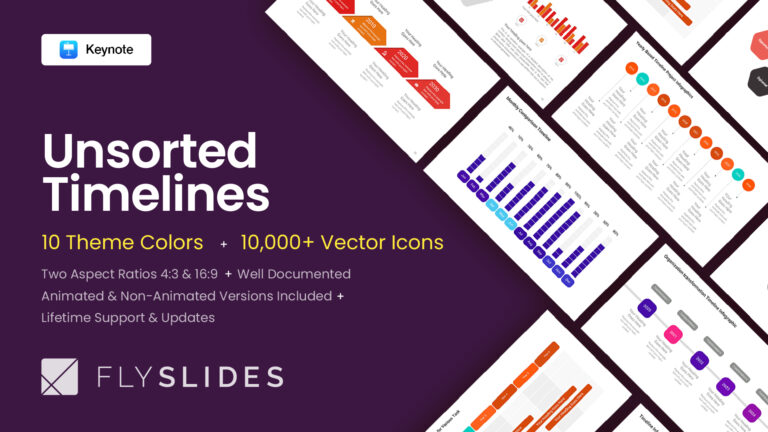
Unsorted Timelines Infographic Diagrams Keynote Template
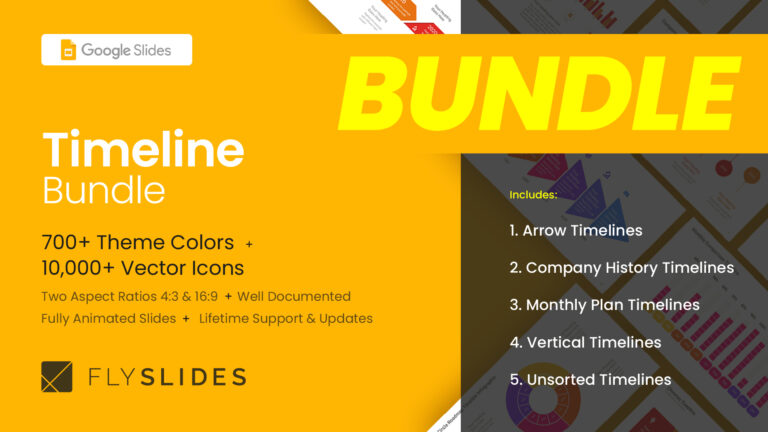
Timeline Bundle Infographic Diagrams Google Slides Template (Theme)

Unsorted Timelines Infographic Diagrams Google Slides Template (Theme)

Timeline Bundle Infographic Diagrams PowerPoint (PPT) Template

Unsorted Timelines Infographic Diagrams PowerPoint (PPT) Template
Read more interesting posts.

Global SharePoint Diary Site Logo
Global SharePoint
The king of SharePoint and Microsoft Power Platform.
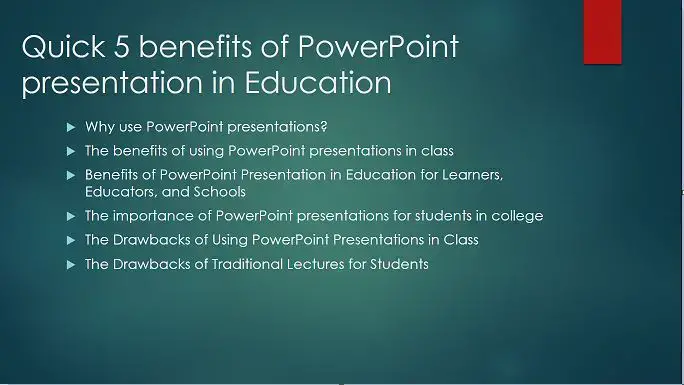
Quick 5 benefits of PowerPoint presentation in Education
Benefits of PowerPoint Presentation in Education: When it comes to teaching, every educator has their own methods. Some may thrive in a lecture setting, while others prefer an interactive environment where students can participate and ask questions. With many schools switching from traditional lectures to PowerPoint presentations, you might wonder which is best for your class. Which style of teaching is more beneficial for your students?
That answer will differ depending on your teaching style, the subject matter of your course, and how much interaction you want from your students. Both methods have pros and cons, but it largely depends on the class you’re teaching. If you’re still unsure which one is better for you and your students, keep reading to learn more about the benefits of PowerPoint presentations in education over traditional lecturing.
Table of Contents
Why use PowerPoint presentations?
PowerPoint presentations have become a staple of business meetings, but they can also be helpful in the classroom. For example, if your students are taking an English literature course and are reading a novel or poetry collection, using a PowerPoint presentation can make it easier to get through the material.
Students can focus on the author’s words while you move the PowerPoint slides to help them understand them. Unlike a traditional lecture, where one person speaks and everyone else listens, PowerPoint presentations allow for more interactive learning.
Students have the chance to respond to the material and learn from their peers, making the class more of a collaborative experience. PowerPoint presentations are also a great way to get students involved and engaged in the material. They can ask questions about the content and interact with one another during the presentation.
Even though you’re at the front of the classroom, PowerPoint can help you get the class involved. If you want to incorporate more visual aids into your course, PowerPoint presentations are a great way to do so. Some studies have shown that humans remember what they’ve seen more than what they’ve heard. Therefore, using PowerPoint presentations in the classroom could improve students’ retention and memory.
The benefits of using PowerPoint presentations in class
Using PowerPoint presentations in class has many benefits for educators and students. Primarily, it can help you save time. Instead of spending a large chunk of your class time lecturing, you can condense your information into a PowerPoint presentation, allowing you to move on to other concepts quickly.
It is also easy to share your PowerPoint presentations with your students outside of class, especially using cloud-based apps. You can also use your presentations to organize your thoughts and keep track of your course outline at a glance. PowerPoint presentations are a great way to incorporate visuals into your lessons, making concepts easier to grasp for students who learn better visually. Students can also use their laptops or computers to view your PowerPoint presentation, making it easy for them to follow along without having to be directly at your computer.
Please don’t give up if you’re struggling to stay focused in class because you find technology distractive. You can engage CustomWritings to help you learn the ropes. As a custom presentation writing service, it has specialized in helping struggling students catch up with the rest by providing high-quality projects, PPTs, speeches, and essays are written from scratch. They can handle PowerPoint presentations of all kinds and levels. Visit their website for inquiries and orders, and you won’t be disappointed.
Benefits of PowerPoint Presentation in Education for Learners, Educators, and Schools
These days, when a student walks into a classroom, their expectations are high. They want to be engaged and feel like their time is well spent. They want to learn and get their money’s worth. The best way to do this is by using a PowerPoint presentation to engage them in the learning process.
A PowerPoint presentation is going to allow you to bring in visuals. This, in turn, will help you deliver a more interactive, hands-on lesson that will engage and excite your students. The best way to do this is by collaborating with your students and getting them to bring their creativity into the lesson. PowerPoints have also helped institutions lower operational costs. While the initial cost of acquiring the system, i.e., laptops, projectors, etc., can be high, schools save in the end through less printing, chalkboard paintings, etc. These are just a few advantages of PowerPoint presentations in education.
The importance of PowerPoint presentations for students in college
When students have an opportunity to contribute to the classroom in a meaningful way, they are more likely to feel empowered, invested, and engaged in the material. To make this happen, you will have to open the floor and allow your students to collaborate.
This is where a PowerPoint presentation can shine. It can help your students get hands-on with the material, allowing them to explore different ideas, take risks, and become critical thinkers. The best way to do this is by creating a collaborative workspace that will allow your students to partner up, explore their ideas, and contribute to the lesson in a meaningful way. Additionally, since most learners are addicted to technology, it is easier to grab their attention with PowerPoint presentations.
The Drawbacks of Using PowerPoint Presentations in Class
Although you can use PowerPoint presentations to save time and get your students more engaged in the material, there are a few drawbacks to keep in mind. If you don’t create a clear path for your students to follow, they may get lost. Make sure each slide has a clear, concise message. This can prevent students from getting distracted. Your students also need to know when they should be paying attention to you and when they should be viewing the PowerPoint presentation. This can be hard to manage and may cause students to miss important information.
The Drawbacks of Traditional Lectures for Students
Educators who prefer traditional teaching methods may wonder, “How does PowerPoint help students learn?” If you opt for the traditional lecture setting over a PowerPoint presentation, remember that this is not the most interactive teaching method.
If your students feel like they are sitting in darkness, they may feel disengaged and uninterested in the content, leaving them behind on tests and exams. Another drawback to traditional lectures is that you can’t quickly go back and review the information if a student misses it or needs a refresher. If you make notes on a projector or whiteboard, they are difficult to review after the fact.
Conclusion: Benefits of PowerPoint presentation in Education
Choosing the right style of teaching for your students can be difficult. Luckily, there are pros and cons to both the traditional lecture setting and PowerPoint presentations. When deciding which one is best for your classroom, consider your teaching style, the subject matter of your class, and the amount of interaction you want students to have.
See Also: Top 7 business challenges in SharePoint Online
You may also like this article, SharePoint Challenges: Top 7 business challenges in SharePoint Online
NEWOR MEDIA: Maximize Your Website’s Earnings With AI
About post author.
As a SharePoint and Power Platform Maven, my greatest joy comes from sharing my expertise with colleagues, friends, and the tech community, helping them navigate the ever-evolving world of technology and guiding them through the dynamic landscape of modern technology.
See author's posts
Share this:
Do you have a better solution or question on this topic please leave a comment cancel reply.
| Contact Us: | | | | Copyright © 2024 All rights reserved. |
Prove your humanity
Remember Me
Register | Lost your password?
A password will be e-mailed to you.
Log in | Lost your password?
Username or E-mail:
Log in | Register
Discover more from Global SharePoint
Subscribe now to keep reading and get access to the full archive.
Type your email…
Continue reading
- Center for Innovative Teaching and Learning
- Instructional Guide
Teaching with PowerPoint
When effectively planned and used, PowerPoint (or similar tools, like Google Slides) can enhance instruction. People are divided on the effectiveness of this ubiquitous presentation program—some say that PowerPoint is wonderful while others bemoan its pervasiveness. No matter which side you take, PowerPoint does offer effective ways to enhance instruction when used and designed appropriately.
PowerPoint can be an effective tool to present material in the classroom and encourage student learning. You can use PowerPoint to project visuals that would otherwise be difficult to bring to class. For example, in an anthropology class, a single PowerPoint presentation could project images of an anthropological dig from a remote area, questions asking students about the topic, a chart of related statistics, and a mini quiz about what was just discussed that provides students with information that is visual, challenging, and engaging.
PowerPoint can be an effective tool to present material in the classroom and encourage student learning.
This section is organized in three major segments: Part I will help faculty identify and use basic but important design elements, Part II will cover ways to enhance teaching and learning with PowerPoint, and Part III will list ways to engage students with PowerPoint.
PART I: Designing the PowerPoint Presentation
Accessibility.
- Student accessibility—students with visual or hearing impairments may not be able to fully access a PowerPoint presentation, especially those with graphics, images, and sound.
- Use an accessible layout. Built-in slide template layouts were designed to be accessible: “the reading order is the same for people with vision and for people who use assistive technology such as screen readers” (University of Washington, n.d.). If you want to alter the layout of a theme, use the Slide Master; this will ensure your slides will retain accessibility.
- Use unique and specific slide titles so students can access the material they need.
- Consider how you display hyperlinks. Since screen readers read what is on the page, you may want to consider creating a hyperlink using a descriptive title instead of displaying the URL.
- All visuals and tables should include alt text. Alt text should describe the visual or table in detail so that students with visual impairments can “read” the images with their screen readers. Avoid using too many decorative visuals.
- All video and audio content should be captioned for students with hearing impairments. Transcripts can also be useful as an additional resource, but captioning ensures students can follow along with what is on the screen in real-time.
- Simplify your tables. If you use tables on your slides, ensure they are not overly complex and do not include blank cells. Screen readers may have difficulty providing information about the table if there are too many columns and rows, and they may “think” the table is complete if they come to a blank cell.
- Set a reading order for text on your slides. The order that text appears on the slide may not be the reading order of the text. Check that your reading order is correct by using the Selection Pane (organized bottom-up).
- Use Microsoft’s Accessibility Checker to identify potential accessibility issues in your completed PowerPoint. Use the feedback to improve your PowerPoint’s accessibility. You could also send your file to the Disability Resource Center to have them assess its accessibility (send it far in advance of when you will need to use it).
- Save your PowerPoint presentation as a PDF file to distribute to students with visual impairments.
Preparing for the presentation
- Consider time and effort in preparing a PowerPoint presentation; give yourself plenty of lead time for design and development.
- PowerPoint is especially useful when providing course material online. Consider student technology compatibility with PowerPoint material put on the web; ensure images and graphics have been compressed for access by computers using dial-up connection.
PowerPoint is especially useful when providing course material online.
- Be aware of copyright law when displaying course materials, and properly cite source material. This is especially important when using visuals obtained from the internet or other sources. This also models proper citation for your students.
- Think about message interpretation for PowerPoint use online: will students be able to understand material in a PowerPoint presentation outside of the classroom? Will you need to provide notes and/or other material to help students understand complex information, data, or graphics?
- If you will be using your own laptop, make sure the classroom is equipped with the proper cables, drivers, and other means to display your presentation the way you have intended.
Slide content
- Avoid text-dense slides. It’s better to have more slides than trying to place too much text on one slide. Use brief points instead of long sentences or paragraphs and outline key points rather than transcribing your lecture. Use PowerPoint to cue and guide the presentation.
- Use the Notes feature to add content to your presentation that the audience will not see. You can access the Notes section for each slide by sliding the bottom of the slide window up to reveal the notes section or by clicking “View” and choosing “Notes Page” from the Presentation Views options.
- Relate PowerPoint material to course objectives to reinforce their purpose for students.
Number of slides
- As a rule of thumb, plan to show one slide per minute to account for discussion and time and for students to absorb the material.
- Reduce redundant or text-heavy sentences or bullets to ensure a more professional appearance.
- Incorporate active learning throughout the presentation to hold students’ interest and reinforce learning.
Emphasizing content
- Use italics, bold, and color for emphasizing content.
- Use of a light background (white, beige, yellow) with dark typeface or a dark background (blue, purple, brown) with a light typeface is easy to read in a large room.
- Avoid using too many colors or shifting colors too many times within the presentation, which can be distracting to students.
- Avoid using underlines for emphasis; underlining typically signifies hypertext in digital media.
Use of a light background with dark typeface or a dark background with a light typeface is easy to read in a large room.
- Limit the number of typeface styles to no more than two per slide. Try to keep typeface consistent throughout your presentation so it does not become a distraction.
- Avoid overly ornate or specialty fonts that may be harder for students to read. Stick to basic fonts so as not to distract students from the content.
- Ensure the typeface is large enough to read from anywhere in the room: titles and headings should be no less than 36-40-point font. The subtext should be no less than 32-point font.
Clip art and graphics
- Use clip art and graphics sparingly. Research shows that it’s best to use graphics only when they support the content. Irrelevant graphics and images have been proven to hinder student learning.
- Photographs can be used to add realism. Again, only use photographs that are relevant to the content and serve a pedagogical purpose. Images for decorative purposes are distracting.
- Size and place graphics appropriately on the slide—consider wrapping text around a graphic.
- Use two-dimensional pie and bar graphs rather than 3D styles which can interfere with the intended message.
Use clip art and graphics sparingly. Research shows that it’s best to use graphics only when they support the content.
Animation and sound
- Add motion, sound, or music only when necessary. When in doubt, do without.
- Avoid distracting animations and transitions. Excessive movement within or between slides can interfere with the message and students find them distracting. Avoid them or use only simple screen transitions.
Final check
- Check for spelling, correct word usage, flow of material, and overall appearance of the presentation.
- Colleagues can be helpful to check your presentation for accuracy and appeal. Note: Errors are more obvious when they are projected.
- Schedule at least one practice session to check for timing and flow.
- PowerPoint’s Slide Sorter View is especially helpful to check slides for proper sequencing as well as information gaps and redundancy. You can also use the preview pane on the left of the screen when you are editing the PowerPoint in “Normal” view.
- Prepare for plan “B” in case you have trouble with the technology in the classroom: how will you provide material located on your flash drive or computer? Have an alternate method of instruction ready (printing a copy of your PowerPoint with notes is one idea).
PowerPoint’s Slide Sorter View is especially helpful to check slides for proper sequencing and information gaps and redundancy.
PowerPoint Handouts
PowerPoint provides multiple options for print-based handouts that can be distributed at various points in the class.
Before class: students might like having materials available to help them prepare and formulate questions before the class period.
During class: you could distribute a handout with three slides and lines for notes to encourage students to take notes on the details of your lecture so they have notes alongside the slide material (and aren’t just taking notes on the slide content).
After class: some instructors wait to make the presentation available after the class period so that students concentrate on the presentation rather than reading ahead on the handout.
Never: Some instructors do not distribute the PowerPoint to students so that students don’t rely on access to the presentation and neglect to pay attention in class as a result.
- PowerPoint slides can be printed in the form of handouts—with one, two, three, four, six, or nine slides on a page—that can be given to students for reference during and after the presentation. The three-slides-per-page handout includes lined space to assist in note-taking.
- Notes Pages. Detailed notes can be printed and used during the presentation, or if they are notes intended for students, they can be distributed before the presentation.
- Outline View. PowerPoint presentations can be printed as an outline, which provides all the text from each slide. Outlines offer a welcome alternative to slide handouts and can be modified from the original presentation to provide more or less information than the projected presentation.
The Presentation
Alley, Schreiber, Ramsdell, and Muffo (2006) suggest that PowerPoint slide headline design “affects audience retention,” and they conclude that “succinct sentence headlines are more effective” in information recall than headlines of short phrases or single words (p. 233). In other words, create slide titles with as much information as is used for newspapers and journals to help students better understand the content of the slide.
- PowerPoint should provide key words, concepts, and images to enhance your presentation (but PowerPoint should not replace you as the presenter).
- Avoid reading from the slide—reading the material can be perceived as though you don’t know the material. If you must read the material, provide it in a handout instead of a projected PowerPoint slide.
- Avoid moving a laser pointer across the slide rapidly. If using a laser pointer, use one with a dot large enough to be seen from all areas of the room and move it slowly and intentionally.
Avoid reading from the slide—reading the material can be perceived as though you don’t know the material.
- Use a blank screen to allow students to reflect on what has just been discussed or to gain their attention (Press B for a black screen or W for a white screen while delivering your slide show; press these keys again to return to the live presentation). This pause can also be used for a break period or when transitioning to new content.
- Stand to one side of the screen and face the audience while presenting. Using Presenter View will display your slide notes to you on the computer monitor while projecting only the slides to students on the projector screen.
- Leave classroom lights on and turn off lights directly over the projection screen if possible. A completely dark or dim classroom will impede notetaking (and may encourage nap-taking).
- Learn to use PowerPoint efficiently and have a back-up plan in case of technical failure.
- Give yourself enough time to finish the presentation. Trying to rush through slides can give the impression of an unorganized presentation and may be difficult for students to follow or learn.
PART II: Enhancing Teaching and Learning with PowerPoint
Class preparation.
PowerPoint can be used to prepare lectures and presentations by helping instructors refine their material to salient points and content. Class lectures can be typed in outline format, which can then be refined as slides. Lecture notes can be printed as notes pages (notes pages: Printed pages that display author notes beneath the slide that the notes accompany.) and could also be given as handouts to accompany the presentation.
Multimodal Learning
Using PowerPoint can help you present information in multiple ways (a multimodal approach) through the projection of color, images, and video for the visual mode; sound and music for the auditory mode; text and writing prompts for the reading/writing mode; and interactive slides that ask students to do something, e.g. a group or class activity in which students practice concepts, for the kinesthetic mode (see Part III: Engaging Students with PowerPoint for more details). Providing information in multiple modalities helps improve comprehension and recall for all students.
Providing information in multiple modalities helps improve comprehension and recall for all students.
Type-on Live Slides
PowerPoint allows users to type directly during the slide show, which provides another form of interaction. These write-on slides can be used to project students’ comments and ideas for the entire class to see. When the presentation is over, the new material can be saved to the original file and posted electronically. This feature requires advanced preparation in the PowerPoint file while creating your presentation. For instructions on how to set up your type-on slide text box, visit this tutorial from AddictiveTips .
Write or Highlight on Slides
PowerPoint also allows users to use tools to highlight or write directly onto a presentation while it is live. When you are presenting your PowerPoint, move your cursor over the slide to reveal tools in the lower-left corner. One of the tools is a pen icon. Click this icon to choose either a laser pointer, pen, or highlighter. You can use your cursor for these options, or you can use the stylus for your smart podium computer monitor or touch-screen laptop monitor (if applicable).
Just-In-Time Course Material
You can make your PowerPoint slides, outline, and/or notes pages available online 24/7 through Blackboard, OneDrive, other websites. Students can review the material before class, bring printouts to class, and better prepare themselves for listening rather than taking a lot of notes during the class period. They can also come to class prepared with questions about the material so you can address their comprehension of the concepts.
PART III: Engaging Students with PowerPoint
The following techniques can be incorporated into PowerPoint presentations to increase interactivity and engagement between students and between students and the instructor. Each technique can be projected as a separate PowerPoint slide.
Running Slide Show as Students Arrive in the Classroom
This technique provides visual interest and can include a series of questions for students to answer as they sit waiting for class to begin. These questions could be on future texts or quizzes.
- Opening Question : project an opening question, e.g. “Take a moment to reflect on ___.”
- Think of what you know about ___.
- Turn to a partner and share your knowledge about ___.
- Share with the class what you have discussed with your partner.
- Focused Listing helps with recall of pertinent information, e.g. “list as many characteristics of ___, or write down as many words related to ___ as you can think of.”
- Brainstorming stretches the mind and promotes deep thinking and recall of prior knowledge, e.g. “What do you know about ___? Start with your clearest thoughts and then move on to those what are kind of ‘out there.’”
- Questions : ask students if they have any questions roughly every 15 minutes. This technique provides time for students to reflect and is also a good time for a scheduled break or for the instructor to interact with students.
- Note Check : ask students to “take a few minutes to compare notes with a partner,” or “…summarize the most important information,” or “…identify and clarify any sticking points,” etc.
- Questions and Answer Pairs : have students “take a minute to come with one question then see if you can stump your partner!”
- The Two-Minute Paper allows the instructor to check the class progress, e.g. “summarize the most important points of today’s lecture.” Have students submit the paper at the end of class.
- “If You Could Ask One Last Question—What Would It Be?” This technique allows for students to think more deeply about the topic and apply what they have learned in a question format.
- A Classroom Opinion Poll provides a sense of where students stand on certain topics, e.g. “do you believe in ___,” or “what are your thoughts on ___?”
- Muddiest Point allows anonymous feedback to inform the instructor if changes and or additions need to be made to the class, e.g. “What parts of today’s material still confuse you?”
- Most Useful Point can tell the instructor where the course is on track, e.g. “What is the most useful point in today’s material, and how can you illustrate its use in a practical setting?”
Positive Features of PowerPoint
- PowerPoint saves time and energy—once the presentation has been created, it is easy to update or modify for other courses.
- PowerPoint is portable and can be shared easily with students and colleagues.
- PowerPoint supports multimedia, such as video, audio, images, and
PowerPoint supports multimedia, such as video, audio, images, and animation.
Potential Drawbacks of PowerPoint
- PowerPoint could reduce the opportunity for classroom interaction by being the primary method of information dissemination or designed without built-in opportunities for interaction.
- PowerPoint could lead to information overload, especially with the inclusion of long sentences and paragraphs or lecture-heavy presentations with little opportunity for practical application or active learning.
- PowerPoint could “drive” the instruction and minimize the opportunity for spontaneity and creative teaching unless the instructor incorporates the potential for ingenuity into the presentation.
As with any technology, the way PowerPoint is used will determine its pedagogical effectiveness. By strategically using the points described above, PowerPoint can be used to enhance instruction and engage students.
Alley, M., Schreiber, M., Ramsdell, K., & Muffo, J. (2006). How the design of headlines in presentation slides affects audience retention. Technical Communication, 53 (2), 225-234. Retrieved from https://www.jstor.org/stable/43090718
University of Washington, Accessible Technology. (n.d.). Creating accessible presentations in Microsoft PowerPoint. Retrieved from https://www.washington.edu/accessibility/documents/powerpoint/
Selected Resources
Brill, F. (2016). PowerPoint for teachers: Creating interactive lessons. LinkedIn Learning . Retrieved from https://www.lynda.com/PowerPoint-tutorials/PowerPoint-Teachers-Create-Interactive-Lessons/472427-2.html
Huston, S. (2011). Active learning with PowerPoint [PDF file]. DE Oracle @ UMUC . Retrieved from http://contentdm.umuc.edu/digital/api/collection/p16240coll5/id/78/download
Microsoft Office Support. (n.d.). Make your PowerPoint presentations accessible to people with disabilities. Retrieved from https://support.office.com/en-us/article/make-your-powerpoint-presentations-accessible-to-people-with-disabilities-6f7772b2-2f33-4bd2-8ca7-ae3b2b3ef25
Tufte, E. R. (2006). The cognitive style of PowerPoint: Pitching out corrupts within. Cheshire, CT: Graphics Press LLC.
University of Nebraska Medical Center, College of Medicine. (n.d.). Active Learning with a PowerPoint. Retrieved from https://www.unmc.edu/com/_documents/active-learning-ppt.pdf
University of Washington, Department of English. (n.d.). Teaching with PowerPoint. Retrieved from https://english.washington.edu/teaching/teaching-powerpoint
Vanderbilt University, Center for Teaching. (n.d.). Making better PowerPoint presentations. Retrieved from https://cft.vanderbilt.edu/guides-sub-pages/making-better-powerpoint-presentations/

Suggested citation
Northern Illinois University Center for Innovative Teaching and Learning. (2020). Teaching with PowerPoint. In Instructional guide for university faculty and teaching assistants. Retrieved from https://www.niu.edu/citl/resources/guides/instructional-guide
Phone: 815-753-0595 Email: [email protected]
Connect with us on
Facebook page Twitter page YouTube page Instagram page LinkedIn page
- Skip to main content
- Skip to main navigation
Effective PowerPoint
PowerPoint is common in college classrooms, yet slide technology is not more effective for student learning than other styles of lecture (Levasseur & Sawyer, 2006). While research indicates which practices support learning and clarifies students’ attitudes toward PowerPoint, effective PowerPoint is not an exact science; few rules can be applied universally. Instructors should consider their audience and their pedagogical goals.
What Students Think
Although students do not necessarily learn more when PowerPoint is used, students prefer slide technology and think they learn better from it (Suskind, 2005). Students also rate instructors who use PowerPoint more highly. One study found about a six percent bump in student ratings of instructors who use PowerPoint over those who don’t (Apperson et al., 2006). Students indicate that what they like most about PowerPoint is that it organizes information, keeps them interested, and helps “visual learners” (Hill et al., 2012). They also, however, critique PowerPoint when slides have too many words, irrelevant clip art, unnecessary movement or animations, and too many colors (Vanderbilt University).
Research-Supported Methods
Like all teaching methods, the use of PowerPoint requires that teachers consider and make use of students’ need for variety. If used as one tool among many, lecturing with PowerPoint adds variety to a course, possibly minimizing student distractions (Bunce et al, 2010).
Minimal Text
In the interest of variety, PowerPoint lectures should not be excessively long, but the number of slides used in lectures has no direct impact on teaching effectiveness. However, the amount of text per slide is consequential. One study found that slides containing three or fewer bullet points and twenty or fewer words were more effective than slides with higher density (Brock, et al., 2011). Less text on each slide also reduces the amount of simultaneous delivery of material in text and speech, that is, presenters reading out loud the text on the slide, which is an additional barrier to comprehension. Studies show that audiences comprehend less when the same material is simultaneously delivered by text and speech and that for many settings, audio-only delivery of text is more effective.
This process is explained by the cognitive load theory , which states that since working memory is limited and each form of presentation of new material (written text, audio instruction, visual diagram, etc.) requires its own allotment of working memory to process, the amount of working memory available for learning is hindered by unnecessary redundancies in presentation. These effects are more pronounced when multiple presentations of information are processed in the same cognitive domain—such as audio instructions and visual text, both processed in the language domain, known as the “phonological loop” (Kalyuga et al., 2004).
Assertion-Evidence Method
The traditional use of PowerPoint, determined mostly by software programming defaults, involves crafting slides with a topic, question, or theme in the upper banner, followed by text bullet points in the body of the slide. A more effective way to present material is with the Assertion-Evidence Method (see graphic), in which the top banner makes an assertion, written in sentence form (think of crafting the assertion in the style of a newspaper headline). The body of the slide then contains visual evidence of the assertion—if possible, in the form of a simple chart, but pictures and brief text can also serve as evidence. This method has been linked with better understanding and long-term retention (Garner & Alley, 2013).
Traditional Topic and Bullet-Point Method

Practical Tips
The research above—as well as research about learning in general—encourages certain practices when using PowerPoint:
- For variety, use the hyperlink or embed features of PowerPoint to incorporate audio or video media.
- To reduce cognitive load, blank out the projector when answering a question or dealing with an issue not directly related to the slide.
- Also to reduce cognitive load, don’t talk while students are writing. If you have minimal text, the instructor should be able—without much disruption in the flow of oration—to display the text and let students silently read before proceeding to elaborate.
- To encourage interactive learning , incorporate questions into PowerPoint presentations. These can be used for discussion, pause-and-ponder, brief writing exercises, etc.
Apperson, J., Laws, E., & Scepansky, J. (2006). The impact of presentation graphics on students’ experience in the classroom. Computers & Education 47 , 116-126.
Brock, S. Joglekar, Y., & Cohen, E. (2011). Empowering PowerPoint: Slides and teaching effectiveness. Interdisciplinary Journal of Information, Knowledge & Management, 6 , 85-94.
Bunce, D. M., Flens, E. A., & Neiles, K. Y. (2010). How long can students pay attention in class? A study of student attention using clickers. Journal of Chemical Education , 87 (12, 1438-1443.
Garner, J. K., & Alley, M. P (2013). How the design of presentation slides affects audience comprehension: A case for the assertion-evidence approach. International Journal of Engineering Education, 29 (6), 1564-1579.
Hill, A., Arford, T., Lubitow, A., & Smollin, L. M. (2012). “I’m ambivalent about it”: The dilemmas of PowerPoint. Teaching Sociology, 40 (3), 242-256.
Kalyuga, S., Chandler, P., & Sweller, J. (2004). When redundant on-screen text in multimedia technical instruction can interfere with learning. Human Factors, 46 (3), 567-581.
Levasseur, D. G., & Sawyer, J. K. (2006). Pedagogy meets PowerPoint: A research review of the effects of computer-generated slides in the classroom. The Review of Communication, 6 (1/2), 101-123.
Making better PowerPoint presentations (n.d.). Vanderbilt University, Center for Teaching (webpage). Retrieved from https://cft.vanderbilt.edu/guides-sub-pages/making-better-powerpoint-presentations/ .
Suskind, J. E. (2005). PowerPoint’s power in the classroom: Enhancing students’ self-efficacy and attitudes. Computers & Education, 45 (2), 203-215.

Academy for Teaching and Learning
Moody Library, Suite 201
One Bear Place Box 97189 Waco, TX 76798-7189
- General Information
- Academics & Research
- Administration
- Gateways for ...
- About Baylor
- Give to Baylor
- Social Media
- Strategic Plan
- College of Arts & Sciences
- Diana R. Garland School of Social Work
- George W. Truett Theological Seminary
- Graduate School
- Hankamer School of Business
- Honors College
- Louise Herrington School of Nursing
- Research at Baylor University
- Robbins College of Health and Human Sciences
- School of Education
- School of Engineering & Computer Science
- School of Music
- University Libraries, Museums, and the Press
- More Academics
- Compliance, Risk and Safety
- Human Resources
- Marketing and Communications
- Office of General Counsel
- Office of the President
- Office of the Provost
- Operations, Finance & Administration
- Senior Administration
- Student Life
- University Advancement
- Undergraduate Admissions
- Graduate Admissions
- Baylor Law School Admissions
- Social Work Graduate Programs
- George W. Truett Theological Seminary Admissions
- Online Graduate Professional Education
- Virtual Tour
- Visit Campus
- Alumni & Friends
- Faculty & Staff
- Prospective Faculty & Staff
- Prospective Students
- Anonymous Reporting
- Annual Fire Safety and Security Notice
- Cost of Attendance
- Digital Privacy
- Legal Disclosures
- Mental Health Resources
- Web Accessibility
- Data Analytics
- Data-Visualisation
- Certified Information Security (CISM) / CISSP / CISA
- Cisco-(CCNP)
- Google Cloud
- Microsoft Azure
- Product Management
- Web Development
- Java Script
- Strategic Thinking
- Time Management
- Working from Home
- Entrepreneurship
- Interpersonal Communication
- Personal Branding
- Graphic Design
- UX/UI Design
- Motion Graphics
- Film & Video
- Copy Writing
- Life Coaching
- Team Building
- All Articles
- Data Science
- IT/Cloud Certifications
- Online Teaching
- Programming
- Soft Skills
Stay in touch!
Never miss out on the latest articles and get sneak peeks of our favorite classes.
May 22, 2023
The Value of PowerPoint in Education: How to Create Engaging Presentations for Student Success
In the realm of education, students embark on a journey of discovery as they weave together words, visuals, and passion to create captivating presentations. It’s not just about delivering information. It’s an art form that:
- hones communication skills
- sparks curiosity
- unleashes the potential within each student.
Amid the hustle and bustle of academic life, students often find themselves caught in a whirlwind of assignments and deadlines. As they navigate the labyrinth of essays, research papers, and exams, time becomes a precious commodity. Creating a presentation can seem like an insurmountable task when the weight of numerous essays bears down on their shoulders. However, with the click of a button, students can get assistance with their essays online.
There are tons of websites where students can find free examples of essays and learn from them. This can alleviate the burden and reclaim their precious time. Embracing the power of virtual support, they can find expert guidance and well-crafted papers. Students can check, let’s say, modern fast fashion argumentative essay topics to produce more writing ideas. No matter what subject you are studying, you can always find help with your and focus on the presentation.
Learn Business Skills Online
Effective Business Presentation Course
Business Course Personal Assessment & Placement
Intro to Business Ethics – Private
A well-crafted PowerPoint can elevate your presentation, capture attention, and enhance understanding.
The importance of presentations
Students are often required to create presentations at school. And no wonder why! There are several reasons for that. Read about them below.
Communication Skills
First of all, it helps students develop and enhance their communication skills. Presentations require them to:
- organize their thoughts
- structure information effectively
- present it in a clear and concise manner.
These skills are essential in various aspects of life, including future careers.
Research and Information Gathering
Presentations usually involve conducting research and gathering relevant information on a particular topic. This process helps students:
- develop their critical thinking skills
- learn how to find reliable sources
- analyze and synthesize information.
Presentation Skills
This form of assignment also develops their public speaking skills. Standing in front of a group and delivering a presentation is a great way to:
- build confidence
- overcome stage fright
- improve their ability to engage and connect with an audience.
Collaboration and Teamwork
In some cases, students may be required to work on presentations as a team. Of course, this encourages:
- collaboration
- cooperation
- the development of teamwork skills.
Students learn how to divide tasks, delegate responsibilities, and work together to create a cohesive and well-rounded presentation.
Subject Mastery
Creating a presentation on a specific topic requires students to comprehend the subject matter. To present information effectively, students need to have a deep understanding of the topic. In turn, this helps them consolidate their knowledge and develop expertise in that area.
Technology Skills
Presentations often involve the use of technology tools. They can be special software (e.g., PowerPoint, Google Slides) or multimedia elements (e.g., images, videos). So this way, students become familiar with various technological tools. In fact, they learn how to use them effectively. In the long run, it improves their digital literacy and technological skills.
Assessment and Evaluation
Presentations serve as a form of assessment for teachers. They allow teachers to:
- assess students’ ability to research
- present information.
This form of work also provides an opportunity for students to identify areas for improvement and refine their skills.

Creating an effective PowerPoint presentation
A well-crafted PowerPoint can elevate your presentation, capture attention, and enhance understanding. To help you create it, here’s a step-by-step guide.
Make a plan
Start by outlining the key points and structure of your presentation. Determine the main message you want to convey and identify supporting ideas. Plan the flow of your slides to ensure a logical and coherent sequence.
Keep It Simple
Simplicity is crucial when designing PowerPoint slides. Avoid cluttered layouts and excessive text. Use concise bullet points or visuals to convey your message effectively. Remember, your slides should complement your presentation, not overpower it.
Visual Appeal
Choose visually appealing templates and color schemes that align with your topic and maintain consistency throughout the presentation. Use high-quality images, charts, and graphs to enhance engagement. Limit animations and transitions to maintain a professional and focused atmosphere.
Use Legible Fonts
Select clear and legible fonts that are easy to read. Avoid using decorative or overly stylized fonts that may hinder readability. UInstead, use font sizes that can be comfortably read from a distance, ensuring that all audience members can follow along.
Utilize Visual Hierarchy
Turn to hierarchy techniques to emphasize key points. Use font size, bolding, or color to highlight important information. This helps guide the audience’s attention and ensures that the most critical elements stand out.
Concise Slide Content
Limit the amount of text on each slide to essential points or brief summaries. Avoid lengthy paragraphs or excessive details. Use bullet points or short phrases to convey information concisely. Remember, the audience should listen to you, not read lengthy paragraphs on the screen.
Engage with Multimedia
Incorporate multimedia elements strategically. Embed relevant videos, audio clips, or interactive elements that add value to your content. Use them sparingly and ensure they contribute to the overall message.
Effective Use of Graphics
Don’t forget to include relevant and meaningful graphics to support your message. Charts, graphs, diagrams, and infographics can help visualize:
- comparisons
Ensure that visuals are:
- labeled appropriately
- easily understood by the audience.
Practice and Timing
Practice your presentation with the PowerPoint slides. You must be familiar with the order and content of each slide. You can also practice pacing yourself to align your spoken words with the visual elements effectively.
Rehearse and Seek Feedback
Rehearse your presentation multiple times, focusing on your delivery and timing. Practice your gestures, tone of voice, and eye contact. You can also ask for feedback from peers or teachers to refine your presentation and make necessary improvements.

Final thoughts
Giving a presentation is a great way to impress your teachers with your knowledge. Mastering the art of excellent presentations may improve your academic experience. And it doesn’t matter whether you are presenting a project, sharing research findings, or giving a speech. Hopefully, our detailed breakdown of how to design a presentation will make you stand out from the crowd.
Trending Articles
Don't forget to share this article!
Related Articles
Healthy Eye Habits for Online Learning Students
How to Write an Essay for a Scholarship
The Art of Instructional Design: Creating Engaging Learning Experiences
Solving Love Puzzle: The Ways Psychic Readings Can Propel Relationships
Chess in Esports: How Grandmasters are Dominating Online Competitive Scenes
Critical Reflections on the Transformative Power of Virtual Education
The Innovative Instructor
Pedagogy – best practices – technology.

PowerPoint in the Classroom
Do you use PowerPoint (or Keynote, Prezi or other presentation software) as part of your teaching? If yes, why? This is not meant to be a question that puts you on the defensive, rather to ask you to reflect on how the use of a presentation application enhances your teaching and fits in with other strategies to meet your learning objectives for the class.
A key point from that post to reiterate: “Duarte reports on research showing that listening and reading are conflicting cognitive processes, meaning that your audience can either read your slides or listen to you; they cannot do both at the same time. However, our brains can handle simultaneous listening to a speaker and seeing relevant visual material.”
It’s important to keep this in mind, particularly if your slides are text heavy. Your students will be scrambling to copy the text verbatim without actually processing what is being said. On the other hand, if your slides are used as prompts (presenting questions or key points with minimal text) or if you don’t use slides at all, students will have to listen to what you are saying, and summarize those concepts in their notes. This process will enhance their understanding of the material.
An article in Focus on Teaching from August 1, 2012 by Maryellen Weimer, PhD asks us to consider Does PowerPoint Help or Hinder Learning? Weimer references a survey of students on the use of PowerPoint by their instructors. A majority of students reported that all or most of their instructors used PowerPoint. Weimer’s expresses the concern that “Eighty-two percent [of students surveyed] said they “always,” “almost always,” or “usually” copy the information on the slides.” She asks, “Does copying down content word-for-word develop the skills needed to organize material on your own? Does it expedite understanding the relationships between ideas? Does it set students up to master the material or to simply memorize it?” Further, she notes that PowerPoint slides that serve as an outline or use bulleted lists may “oversimplify” complex content, encourage passivity, and limit critical thinking.
Four journal articles from Cell Biology Education on PowerPoint in the Classroom (2004 Fall) present different points of view (POV) on the use of PowerPoint. Although written over a decade ago, most of the concepts are still relevant. Be aware that some of the links are no longer working. From the introduction to the series:
Four POVs are presented: 1) David Keefe and James Willett provide their case why PowerPoint is an ideal teaching software. Keefe is an educational researcher at the Center for Technology in Learning at SRI International. Willett is a professor at George Mason University in the Departments of Microbial and Molecular Bioscience; as well as Bioinformatics and Computational Biology. 2) Kim McDonald highlights the causes of PowerPointlessness, a term which indicates the frequent use of PowerPoint as a crutch rather than a tool. She is a Bioscience Educator at the Shodor Education Foundation, Inc. 3) Diana Voss asks readers if PowerPoint is really necessary to present the material effectively or not. Voss is a Instructional Computing Support Specialist at SUNY Stony Brook. 4) Cynthia Lanius takes a light-hearted approach to ask whether PowerPoint is a technological improvement or just a change of pace for teacher and student presentations. Lanius is a Technology Integration Specialist in the Sinton (Texas) Independent School District.
These are short, op-ed style, pieces that will further stimulate your thinking on using presentation software in your teaching.
For more humorous, but none-the-less thought provoking approach, see Rebecca Shuman’s anti-PowerPoint tirade featured in Slate (March 7, 2014): PowerPointless . With the tagline, “Digital slideshows are the scourge of higher education,” Shuman reminds us that “A presentation, believe it or not, is the opening move of a conversation—not the entire conversation.”
Shuman offers a practical guide for those, like her, who do use presentation software, but seek to avoid abusing it. “It is with a few techniques and a little attention, possible to ensure that your presentations rest in the slim minority that are truly interactive and actually help your audience learn.” Speaking.io , the website Shuman references, discusses the use of presentation software broadly, not just for academics, but has many useful ideas and tips.
For a resource specific to academic use, see the University of Central Florida’s Faculty Center for Teaching & Learning’s Effective Use of PowerPoint . The experts at the Center examine the advantages and challenges of using presentation software in the classroom, suggest approaches to take, and discuss in detail using PowerPoint for case studies, with clickers, as worksheets, for online (think flipped classes as well) teaching, the of use presenter view, and demonstrate best practices for delivery and content construction.
Macie Hall, Senior Instructional Designer Center for Educational Resources
Image Source: CC Oliver Tacke https://www.flickr.com/photos/otacke/12635014673/
One thought on “ PowerPoint in the Classroom ”
This post offers a well-framed discussion of the pedagogical choices behind presentation choices we make in our classes–thanks!
Leave a Reply Cancel reply
Your email address will not be published. Required fields are marked *
Quick links
- Make a Gift
- Directories
Teaching with Powerpoint
Pedagogical considerations for powerpoint.
PowerPoint is a presentation program. It automatically creates a sense of formality in a classroom. Many students respond to PowerPoint the same way they respond to a lecture. They tend to be quieter, more inclined to listen than to talk, and even may take notes. If you desire a more relaxed classroom atmosphere, some of the options described later in this chapter offer suggestions for reducing the formality of PowerPoint.
Bridging with PowerPoint
Using PowerPoint when you are in the seminar style classroom can create a sense of technological continuation between the classrooms. You might want to incorporate some of the material produced in the LAN into a PowerPoint presentation.
When and How to Use PowerPoint
How much you use PowerPoint will vary based on your particular teaching style. The next section provides a list of suggestions for incorporating PowerPoint into daily instruction. Keep in mind that using PowerPoint requires planning; you need to prepare your presentation in advance.
You will find detailed instructions on how to use PowerPoint in the CIC Student Guide portion of this manual.
Options for Using Power Point
Option 1: illustrated lectures.
When giving a lecture or mini-lecture, you can use PowerPoint to highlight key points in your presentation. The visual format of PowerPoint allows you to easily project timelines, and images. You can also use PowerPoint to provide an outline of your talk, without writing on the board.

Option 2: Instructions
You can use PowerPoint to present instructions for a paper assignment or class activity. The sequential order of the slides lends itself to providing step-by-step instructions.
Option 3: Paper Proposals
Students can present their paper proposals or outlines to the class via PowerPoint. For example, a student could present his or her claim on one slide, following by an outline for the paper on another. Or the student could combine the table feature to present two possible outlines for the paper side by side.
SAMPLE ASSIGNMENT (Kimberlee Gillis-Bridges)
This assignment gives students the option of using PowerPoint.
The proposal assignment allows you to develop a tentative thesis, pose arguments related to this thesis, identify potential evidence and consider organizational strategies for your comparison/contrast essay. You may submit the proposal in a word-processed format, or you may use PowerPoint. You may also integrate images into the proposal, particularly as you discuss shots and scenes you will analyze in the essay. In completing the proposal, you will produce a roadmap to guide your drafting process.
Although the proposal can take a variety of formats, it should include the following components:
- A tentative title for the essay.
- The names of the films you will compare/contrast.
- The theme you plan to address and an indication of how you plan to narrow the theme.
- A tentative thesis that addresses the significance of the films’ similarities and differences.
- An overview of the similarities and differences you will address in the essay.
- A description of the shots or scenes you plan to analyze, with notes on the arguments you plan to make about these shots and scenes.
- An indication of the order in which you plan to make your points. You may do this in the form of a list, a descriptive outline, or any other format that works for you.
- A list of any questions you have regarding the assignment or your ideas-in-progress.
While I have listed the elements you should include, you can address them in an order you wish. For example, you may integrate the overview of similarities and differences and the listing of shots/scenes into the outline of points. You may also incorporate anything else that will help you draft the essay (excerpts from your electronic responses; quotations from lecture, readings, or others’ electronic responses; notes taken during in-class presentations, etc.).
Option 4: Discussion Prompts
You can use PowerPoint to project a discussion prompt to the class. This technique is particularly suited to a short writing exercise. Since the prompt is already legibly written on the slide, students can refer back to it easily as they complete a writing activity prior to discussion. You can then use PowerPoint to project bulletin board or other class materials relevant to the prompt and/or follow up questions.
Note : projecting a quote from a Bulletin Board discussion followed by a discussion question is a simple and effective way to bridge discussions when moving between rooms.
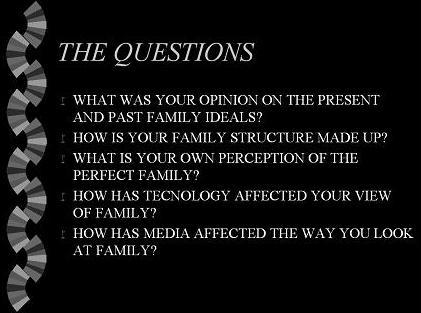

Option 5: Test or Quiz Answers
PowerPoint gives you the ability to project a test or quiz question, discuss it with the class, and then project the answer below or alongside the question. You can also use PowerPoint to project student responses to questions.
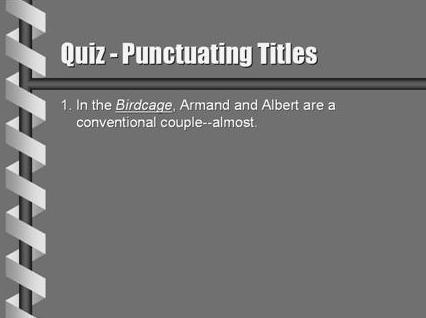
Option 6: Grammar Exercises
You can use PowerPoint to grammatical instructions, samples from student papers, and revised sentences, among other possibilities. The ability to reveal the text on the screen a section at a time allows students to clearly see the editing process.
Option 7: Student Projects
Most of the options described above are also suited to student presentations. You can require students to use PowerPoint for individual or group presentations or you can give students the option of using PowerPoint. You may be surprised how many students will take the option.
SAMPLE EXERCISE: USING POWERPOINT FOR STUDENT-LED GROUP DISCUSSION OF TEXTS (Laurie George)
An excellent pedagogical means of keeping class discussion lively, the discussant pool diverse, and the selected texts intellectually engaging is to assign a pair or a group of students to lead a discussion on a given text. The exercise can include close reading exclusively, or it can include the researching, summarizing, and presenting of one or two critical articles on that text.
The technique works particularly well if presenters are required to quote short passages from the articles on PowerPoint slides and to provide summaries of whatever quoted—a requirement that reinforces in each class session the practice of never allowing a secondary quoted source to stand alone without critical interpretation.
The technique also works well if portions of class sessions are set aside to allow students to research articles (on campus, via the UW Libraries English Research Guide as well as to allow adequate preparation time for presenters to confer and design their PowerPoint drafts—best to set limits on these, say, five or eight slides, as presenters rarely gauge time accurately and always have more to say during the discussion than they initially anticipate.
Also helpful is to require that the last PowerPoint screen include at least two but no more than four questions about the textual subject under discussion/ and or the textual relevance of the articles summarized.
Here’s an example from a senior seminar discussion of Ali Smith’s novel Hotel World :

Below is an explanation I included within my syllabus about using PowerPoint as an aid to discussion leading; the course was a senior seminar that focused on variations of voice in literary texts:
For Group or Solo Presentation (Discussion Leading) Projects
Everyone in class needs to take responsibility for leading a class discussion about a particular aspect of voice used in our course texts.
A short PowerPoint slide show is required for all presentations, and we’ll use class time to prepare at least skeletal drafts of the PowerPoints.
Here’s how to prepare:
- Coordinate with me and other presenters before the actual presentation to ensure variety rather than redundancy in topic matter that centers on style and voice in your assigned text.
- Rehearse your presentation, and if it bores you at any point or doesn’t reveal something interesting about a writer’s voice as conveyed in style, revise the presentation so that it does engage and interest.
- Produce and rely on a brief (3- 5 PowerPoint screens) to cover the points that you are explaining. Quote short textual passages on these screens and mark them so as to make them largely visible and to keep people’s attention on the screen and your voice.
- Use another audio/visual aid (besides your own voice and not just the print book you’re working with) in your presentation to give your presentation pizzazz—and don’t hesitate to employ words like pizzazz in your PowerPoint script, as this is a class about literary voice! Item 1
Additional Resources
- YouTube Comedy Video on How NOT to Use Powerpoint This 4 minute video is a low-key way to introduce students to some of the more extreme abuses of PowerPoint.
- Bedford St. Martins Tutorial on Preparing Presentation Slides This is an online tutorial with some solid nuts and bolts guidelines for building audience-friendly slides. It can also be used as a point of discussion for how "rules of thumb" can cause problems in presenting complex material.
- Excerpt from Edward Tufte's The Cognitive Style of Powerpoint This essay is a classic for critiquing how Powerpoint can reduce the analytical complexity of data and conclusions, in some cases leading to bad and even dangerous decisions in technical environments.
- Newsletter
Learning from PowerPoint: is it time for teachers to move on?
Director, First Year Learning Initiative at University College and Professor of Psychological Sciences, Northern Arizona University
Disclosure statement
Michelle Denise Miller is a partner in Rhizome Learn LLC and consults for Minds-Online.com.
View all partners

For a brief period in the history of teaching, using PowerPoint automatically qualified you as a tech-savvy professor – an innovator who wouldn’t settle for the usual combination of staticky black-and-white overhead films and hand-scrawled chalkboard notes.
Now, it’s hard to believe that PowerPoint was once considered innovative by anyone. Popular criticism includes everything from tongue-in-cheek comments about death by PowerPoint to serious claims that it fundamentally degrades how we think and communicate.
But much of today’s college instruction isn’t in face-to-face classrooms, a setting in which PowerPoint was traditionally used. It’s in the burgeoning field of online learning .
So if more learning is moving online, does that mean that teaching with PowerPoint is becoming a thing of the past?
Surprisingly, the answer is no.
Passive learning through PowerPoint?
Even though there’s little research that directly addresses whether PowerPoint affects learning in college students, critics have questioned its value in educational settings.
Some ask whether PowerPoint might indirectly undermine the quality of teaching by reinforcing a passive learning approach .
We know that lecturing is less effective than alternative methods. It therefore makes sense for teachers in face-to-face classrooms to question how much of their class time ought to be spent on slideshows.
But the fact is “slideshows” remain a popular method for presenting content in today’s online courses.
Technically, these are often not PowerPoints, but decks generated using other types of specialized programs .
And they may differ from standard in-class PowerPoint presentations in important ways.
For example, taking advantage of the increased flexibility of the online environment, they give students more control over how quickly to go through the material and when to backtrack. They can also have more interactive features, such as quizzes, that ask students to apply material while they are learning it.
Even so, the basic – and flawed – idea is the same: put the material in front of students, and learning will happen.
What’s wrong with slideshows in online courses
As a psychologist specializing in teaching techniques and course design, when I talk to faculty about teaching effectively with technology , I sometimes tell them to follow the ABS principle: anything but slideshows.
I’m only half-kidding with that blanket statement.
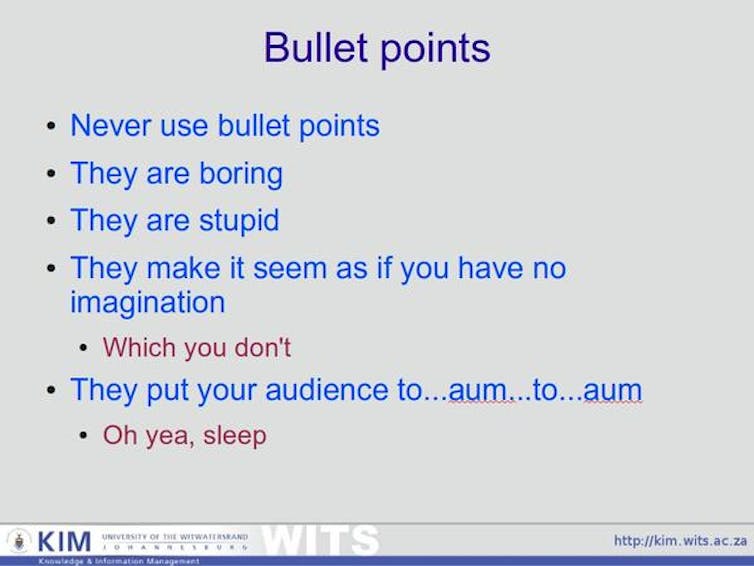
After all, we learn with the same brains in online environments as we do face-to-face; the principles of learning don’t change just because the medium changes. And today’s learning theorists agree: active involvement trumps passive viewing.
Students need to grapple with challenging problems, practice skills, discuss and defend viewpoints. But for this kind of active learning to happen, instructors need to ensure they do not rely too heavily on slides.
There are alternatives: simulations , problem-based learning , even educational games are all proven methods for drawing students in. They also transplant well into online learning .
Using slideshows the right way
So do slideshows have any place in a well-designed online course? Possibly.
They can be used strategically for things they are best at: giving students an overview of new material, or providing a refresher on concepts students will need for an upcoming activity.
Slides are also great for for integrating visual illustrations. This is important because visuals – diagrams, figures, photos and the like – have a powerful impact on learning.
Visual information is almost always more memorable than sound, text or other modalities.
This isn’t because of the now-debunked idea that some people are “visual learners,” but more likely stems from how the brain codes images . There are separate systems for representing verbal and visual information in the brain. When we save information in both places, it is easier to recall.
Teachers don’t have to stick with static images, either. Even basic animations can illuminate conceptual relationships – such as cause and effect, or the unfolding of a process over time – in ways that text can’t.
Furthermore, as University of California, Santa Barbara researcher Richard Mayer has discovered , visuals and the spoken word pair up in powerful ways, so that audio plus visuals produce better learning than either alone.
Research also tells teachers some things not to do with visuals. Instructors should avoid purely decorative graphics, as these can actually hamper learning .
They should also eschew reading text verbatim , instead using a conversational, natural speaking style for voiceovers and verbal explanations.
What this means in the larger context of online learning
In sum, slideshows can be a useful part of online instruction, when used for the right things and designed in the right way. But they shouldn’t be the main, or the only, method of instruction – any more than lectures should dominate face-to-face classes.
But it’s not just instructors who need to hear this message.
Publishing and educational technology companies, who provide many of the tools that educators rely on, can do more to develop products that push beyond familiar formulas and draw on the latest learning science.
We need tools that make it easy to create assignments that ask students to apply what they have learned, in scenarios that are as realistic and challenging as possible.
These learning tools also need to be adaptive, adjusting the material and pace to the individual learner. This kind of educational technology does exist , but far more can be done to expand the available options.
Teaching in the age of technology comes with its own set of opportunities as well as challenges. And online education presents educators and tech developers with a rare opportunity to fundamentally rethink what we do.
Will we use it to explore new avenues for learning, or will we fall back on the the same old techniques that don’t work well in face-to-face classrooms?
- Online learning
- Education technology
- Face-to-face learning
- Online courses

Head of Evidence to Action

Supply Chain - Assistant/Associate Professor (Tenure-Track)

Education Research Fellow

OzGrav Postdoctoral Research Fellow

Casual Facilitator: GERRIC Student Programs - Arts, Design and Architecture
Center for Teaching
Making better powerpoint presentations.
Print Version
Baddeley and Hitch’s model of working memory.
Research about student preferences for powerpoint, resources for making better powerpoint presentations, bibliography.
We have all experienced the pain of a bad PowerPoint presentation. And even though we promise ourselves never to make the same mistakes, we can still fall prey to common design pitfalls. The good news is that your PowerPoint presentation doesn’t have to be ordinary. By keeping in mind a few guidelines, your classroom presentations can stand above the crowd!
“It is easy to dismiss design – to relegate it to mere ornament, the prettifying of places and objects to disguise their banality. But that is a serious misunderstanding of what design is and why it matters.” Daniel Pink
One framework that can be useful when making design decisions about your PowerPoint slide design is Baddeley and Hitch’s model of working memory .

As illustrated in the diagram above, the Central Executive coordinates the work of three systems by organizing the information we hear, see, and store into working memory.
The Phonological Loop deals with any auditory information. Students in a classroom are potentially listening to a variety of things: the instructor, questions from their peers, sound effects or audio from the PowerPoint presentation, and their own “inner voice.”
The Visuo-Spatial Sketchpad deals with information we see. This involves such aspects as form, color, size, space between objects, and their movement. For students this would include: the size and color of fonts, the relationship between images and text on the screen, the motion path of text animation and slide transitions, as well as any hand gestures, facial expressions, or classroom demonstrations made by the instructor.
The Episodic Buffer integrates the information across these sensory domains and communicates with long-term memory. All of these elements are being deposited into a holding tank called the “episodic buffer.” This buffer has a limited capacity and can become “overloaded” thereby, setting limits on how much information students can take in at once.
Laura Edelman and Kathleen Harring from Muhlenberg College , Allentown, Pennsylvania have developed an approach to PowerPoint design using Baddeley and Hitch’s model. During the course of their work, they conducted a survey of students at the college asking what they liked and didn’t like about their professor’s PowerPoint presentations. They discovered the following:
Characteristics students don’t like about professors’ PowerPoint slides
- Too many words on a slide
- Movement (slide transitions or word animations)
- Templates with too many colors
Characteristics students like like about professors’ PowerPoint slides
- Graphs increase understanding of content
- Bulleted lists help them organize ideas
- PowerPoint can help to structure lectures
- Verbal explanations of pictures/graphs help more than written clarifications
According to Edelman and Harring, some conclusions from the research at Muhlenberg are that students learn more when:
- material is presented in short phrases rather than full paragraphs.
- the professor talks about the information on the slide rather than having students read it on their own.
- relevant pictures are used. Irrelevant pictures decrease learning compared to PowerPoint slides with no picture
- they take notes (if the professor is not talking). But if the professor is lecturing, note-taking and listening decreased learning.
- they are given the PowerPoint slides before the class.
Advice from Edelman and Harring on leveraging the working memory with PowerPoint:
- Leverage the working memory by dividing the information between the visual and auditory modality. Doing this reduces the likelihood of one system becoming overloaded. For instance, spoken words with pictures are better than pictures with text, as integrating an image and narration takes less cognitive effort than integrating an image and text.
- Minimize the opportunity for distraction by removing any irrelevant material such as music, sound effects, animations, and background images.
- Use simple cues to direct learners to important points or content. Using text size, bolding, italics, or placing content in a highlighted or shaded text box is all that is required to convey the significance of key ideas in your presentation.
- Don’t put every word you intend to speak on your PowerPoint slide. Instead, keep information displayed in short chunks that are easily read and comprehended.
- One of the mostly widely accessed websites about PowerPoint design is Garr Reynolds’ blog, Presentation Zen . In his blog entry: “ What is Good PowerPoint Design? ” Reynolds explains how to keep the slide design simple, yet not simplistic, and includes a few slide examples that he has ‘made-over’ to demonstrate how to improve its readability and effectiveness. He also includes sample slides from his own presentation about PowerPoint slide design.
- Another presentation guru, David Paradi, author of “ The Visual Slide Revolution: Transforming Overloaded Text Slides into Persuasive Presentations ” maintains a video podcast series called “ Think Outside the Slide ” where he also demonstrates PowerPoint slide makeovers. Examples on this site are typically from the corporate perspective, but the process by which content decisions are made is still relevant for higher education. Paradi has also developed a five step method, called KWICK , that can be used as a simple guide when designing PowerPoint presentations.
- In the video clip below, Comedian Don McMillan talks about some of the common misuses of PowerPoint in his routine called “Life After Death by PowerPoint.”
- This article from The Chronicle of Higher Education highlights a blog moderated by Microsoft’s Doug Thomas that compiles practical PowerPoint advice gathered from presentation masters like Seth Godin , Guy Kawasaki , and Garr Reynolds .
Presenting to Win: The Art of Telling Your Story , by Jerry Weissman, Prentice Hall, 2006
Presentation Zen: Simple Ideas on Presentation Design and Delivery , by Garr Reynolds, New Riders Press, 2008
Solving the PowerPoint Predicament: using digital media for effective communication , by Tom Bunzel , Que, 2006
The Cognitive Style of Power Point , by Edward R. Tufte, Graphics Pr, 2003
The Visual Slide Revolution: Transforming Overloaded Text Slides into Persuasive Presentations , by Dave Paradi, Communications Skills Press, 2000
Why Most PowerPoint Presentations Suck: And How You Can Make Them Better , by Rick Altman, Harvest Books, 2007

Teaching Guides
- Online Course Development Resources
- Principles & Frameworks
- Pedagogies & Strategies
- Reflecting & Assessing
- Challenges & Opportunities
- Populations & Contexts
Quick Links
- Services for Departments and Schools
- Examples of Online Instructional Modules

- Onsite training
3,000,000+ delegates
15,000+ clients
1,000+ locations
- KnowledgePass
- Log a ticket
01344203999 Available 24/7

What are the Advantages and Disadvantages of PowerPoint
Explore the Advantages and Disadvantages of PowerPoint in our latest blog. Discover how this popular presentation tool can enhance communication and engagement while also exploring potential pitfalls. Gain insights on harnessing its power for effective presentations and navigating its limitations for more impactful business and educational content.

Exclusive 40% OFF
Training Outcomes Within Your Budget!
We ensure quality, budget-alignment, and timely delivery by our expert instructors.
Share this Resource
- Microsoft Dynamics 365 Fundamentals (ERP) MB920
- Microsoft Access Training
- Microsoft Dynamics 365 Fundamentals (CRM) MB910
- Microsoft Word Course
- Microsoft Dynamics 365 Marketing MB220

The average salary of a PowerPoint expert in the UK is £40,000 GBP per year, according to Talent.com . In this blog, you will get to know about the Advantages and Disadvantages of PowerPoint. Let's dive in deeper to learn how it can impact your presentations!
Table of Contents
1) Advantages of PowerPoint
2) Visual appeal and aesthetic design
a) Easy to use and accessible
b) Efficient information organisation
c) Disadvantages of PowerPoint
3) Conclusion
Advantages of PowerPoint
PowerPoint is a powerful software tool developed by Microsoft that enables users to create visually appealing and engaging presentations. It offers various functionalities and features that make it a popular choice for individuals and professionals who want to convey information effectively. Here, we will explore the Advantages of PowerPoint and how it can enhance your presentations. Let's dive into the benefits it offers:
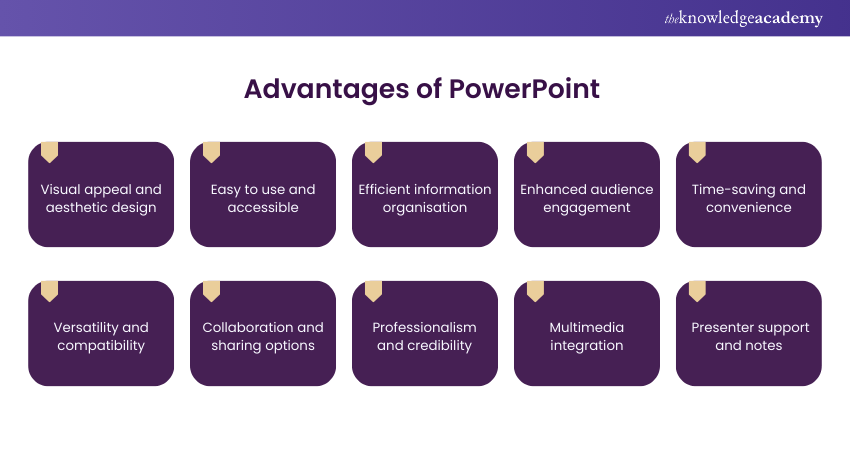
Visual appeal and aesthetic design
One of the primary Advantages of PowerPoint is its ability to create visually appealing presentations. With a vast array of design templates, colour schemes, and graphical elements, PowerPoint allows you to add visual appeal to your slides. This visual enhancement can captivate your audience's attention and make your presentation more engaging.
Easy to use and accessible
PowerPoint is known for its user-friendly interface, making it accessible to users of any level. Its intuitive design and straightforward navigation enable users to create presentations quickly and efficiently. Moreover, PowerPoint is compatible with various operating systems, ensuring broad accessibility across different devices.
Efficient information organisation
One of the significant Advantages of PowerPoint is its capability to organise information effectively. With features like bullet points, numbered lists, and hierarchical structures, you can present your ideas in a logical and organised manner. This helps your audience understand and retain the information more easily.

Enhanced audience engagement
PowerPoint offers various features to enhance audience engagement during presentations. Animations, transitions, and multimedia elements can make your slides dynamic and captivating. Additionally, interactive features like hyperlinks and embedded videos can encourage audience participation, making your presentation more memorable.
Time-saving and convenience
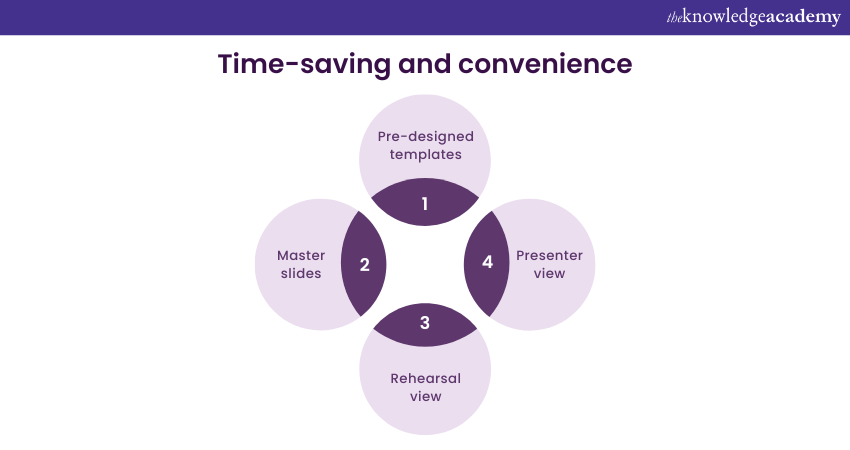
These templates offer professionally designed layouts and graphics, allowing you to focus on the content rather than spending hours on design. Furthermore, PowerPoint's autosave feature automatically saves your work, providing convenience and peace of mind.
Versatility and compatibility
PowerPoint's versatility is another key advantage that sets it apart as a presentation tool. It offers broad features and compatibility options that make it highly adaptable to different content formats and sharing platforms.
a) Support for various media formats:
PowerPoint provides support for a diverse range of media formats, allowing you to incorporate different types of content into your presentations. You can seamlessly integrate images, videos, audio clips, and charts, enhancing your slides' visual appeal and interactivity. You can create engaging and immersive presentations that resonate with your audience by leveraging these multimedia elements.
The ability to incorporate various media formats in PowerPoint allows you to leverage different modes of communication. Visual elements, such as images and charts, can help illustrate complex concepts or data, making them more understandable and memorable. Videos and audio clips, on the other hand, can add a dynamic and interactive element to your presentation, allowing you to deliver information in a more engaging and captivating way.
Want to enhance your productivity and proficiency in using Microsoft software? Register for our Microsoft Office Courses . Join now!
b) File conversion and sharing options:
Powerpoint Presentations can be easily converted to different file formats, offering flexibility in sharing and distribution. Whether you need to share your presentation with colleagues, clients, or a wider audience, PowerPoint enables you to save your slides in formats such as PDFs, video files, or even images. This versatility ensures that your presentation can be accessed and viewed on various devices and platforms, making it convenient for your audience to engage with your content.
Converting your presentation to PDF format can be particularly useful when you want to share a finalised version of your slides while preserving the formatting and layout. PDF files are widely compatible, allowing anyone to view them using a PDF reader without the need for specific presentation software.
In addition to PDF, Powerpoint Presentations can also be saved as video files. This format is ideal for situations where you want to share your presentation online, embed it on a website, or upload it to video-sharing platforms. By converting your presentation to a video, you can ensure a consistent playback experience across different devices and platforms.
Furthermore, Powerpoint Presentations can be easily shared through various online platforms and cloud storage services. Whether you choose to use email, file-sharing platforms, or cloud storage solutions like OneDrive or Google Drive, PowerPoint's compatibility allows you to collaborate with others and share your presentations effortlessly.
Collaboration and sharing options
Collaboration is made easy with PowerPoint's sharing and collaboration features. Multiple users can work on a presentation at the same time, making it ideal for team projects or group presentations. With cloud storage and sharing platforms, such as OneDrive or SharePoint, you can share your Powerpoint Presentations with others, enabling seamless collaboration and feedback exchange.
Professionalism and credibility
PowerPoint's professional look and vibes contribute to the overall credibility of your presentation. The polished design and layout options help create a sense of professionalism, which can enhance your message's impact. By using PowerPoint, you can convey your ideas with authority and leave a lasting impression on your audience.
Multimedia integration
Incorporating multimedia elements is a breeze with PowerPoint. You can easily insert images, videos, audio clips, and animations into your slides, making your presentation more dynamic and engaging. Visual and auditory aids can significantly enhance the audience's understanding and retention of information.
Presenter support and notes
PowerPoint offers several features to support presenters during their delivery. The presenter view provides a helpful tool for managing your presentation, displaying speaker notes, and previewing upcoming slides. You can also add speaker notes to individual slides, ensuring that you don't miss any crucial points during your presentation.
Discover the full potential of Microsoft Office 365 and revolutionise your productivity with our Microsoft Office 365 Masterclass. Sign up now!
Disadvantages of PowerPoint
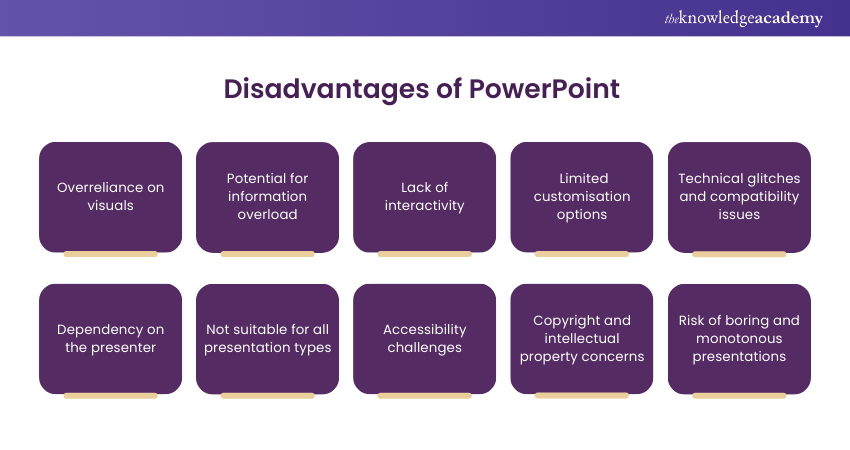
Overreliance on visuals
While visuals can enhance a presentation, overreliance on them can be a disadvantage. When too much emphasis is placed on visuals, the audience may become distracted or miss essential information. It's crucial to strike a balance between visuals and textual content to ensure the message is effectively conveyed.
Potential for information overload
Powerpoint Presentations have the potential to overwhelm the audience with excessive information. Presenters may feel compelled to include every detail on the slides, leading to information overload. It's important to prioritise key points and keep the content concise and focused to prevent overwhelming the audience.
Lack of interactivity
PowerPoint is primarily a one-way communication tool, limiting interactivity during presentations. While you can incorporate interactive elements, such as hyperlinks or quizzes, the level of interaction is often limited. This can hinder audience engagement and participation, particularly in scenarios that require active involvement.
Limited customisation options
While PowerPoint provides various design templates, the customisation options may be limited compared to dedicated design software. Presenters seeking highly customised and unique designs may find PowerPoint's options somewhat restrictive. However, for most presentations, the available templates and customisation features are sufficient.
Technical glitches and compatibility issues
Technical glitches and compatibility issues can occasionally occur when using PowerPoint. File corruption, formatting inconsistencies, or software compatibility problems can disrupt the smooth delivery of your presentation. It's crucial to test your presentation on the actual equipment or platform to minimise the risk of technical difficulties.
Dependency on the presenter
Powerpoint Presentations often rely heavily on the presenter's ability to deliver the content effectively. A presenter who lacks public speaking skills or fails to engage the audience may negatively impact the overall effectiveness of the presentation. Developing strong presentation skills and practising delivering your presentation is important to ensure a successful outcome.
Not suitable for all presentation types
While PowerPoint is a versatile tool, it may not be the best choice for all presentation types. For instance, highly technical or data-heavy presentations may require more specialised software or tools that offer advanced data visualisation capabilities. It's important to assess the specific requirements of your presentation and choose the appropriate tool accordingly.
Accessibility challenges
Powerpoint Presentations may pose accessibility challenges for individuals with disabilities. Issues such as small font sizes, lack of alt text for images, or inadequate colour contrast can make it difficult for visually impaired or hearing-impaired individuals to fully engage with the content. It's important to follow accessibility guidelines and make accommodations to ensure inclusivity.
Copyright and intellectual property concerns
When using images, videos, or other media in Powerpoint Presentations, it's essential to respect copyright and intellectual property rights. Failure to obtain proper permissions or give proper attribution can lead to legal issues. It's crucial to use licensed or royalty-free media or obtain explicit permission from copyright holders before including them in your presentations.
Risk of boring and monotonous presentations
Powerpoint Presentations have earned a reputation for being boring and monotonous if not designed and delivered effectively. The reliance on bullet points and text-heavy slides can result in a lack of variety and engagement. It's important to employ storytelling techniques, incorporate multimedia elements, and vary the presentation format to keep the audience interested and attentive.
Conclusion
We hope you read this blog and understand the Advantages and Disadvantages of PowerPoint. PowerPoint's versatility and compatibility make it a powerful presentation tool. With support for various media formats and easy file conversion, it allows users to create engaging presentations and share them seamlessly. PowerPoint is a valuable resource for effective communication and impactful presentations.
Take your Microsoft Office skills to the next level – sign up for our Power Apps and Power Automate Training !
Frequently Asked Questions
PowerPoint offers twelve common types of slides, including Title, Picture, Text, Agenda, and more, each designed for specific content and presentation purposes.
The three main views in PowerPoint are Normal View for editing, Slide Sorter View for organising slides, and Slide Show View for presenting.
The Knowledge Academy takes global learning to new heights, offering over 30,000 online courses across 490+ locations in 220 countries. This expansive reach ensures accessibility and convenience for learners worldwide.
Alongside our diverse Online Course Catalogue, encompassing 17 major categories, we go the extra mile by providing a plethora of free educational Online Resources like News updates, Blogs , videos, webinars, and interview questions. Tailoring learning experiences further, professionals can maximise value with customisable Course Bundles of TKA .
The Knowledge Academy’s Knowledge Pass , a prepaid voucher, adds another layer of flexibility, allowing course bookings over a 12-month period. Join us on a journey where education knows no bounds
The Knowledge Academy offers various Microsoft Office Training , including the Microsoft PowerPoint Training, Microsoft Access Training and Microsoft Office 365 Training. These courses cater to different skill levels, providing comprehensive insights into Presentation Specialist Job Description .
Our Office Applications Blogs cover a range of topics related to Microsoft Office, offering valuable resources, best practices, and industry insights. Whether you are a beginner or looking to advance your presentation skills, The Knowledge Academy's diverse courses and informative blogs have got you covered.
Upcoming Office Applications Resources Batches & Dates
Thu 5th Sep 2024
Thu 10th Oct 2024
Thu 7th Nov 2024
Thu 5th Dec 2024
Get A Quote
WHO WILL BE FUNDING THE COURSE?
My employer
By submitting your details you agree to be contacted in order to respond to your enquiry
- Business Analysis
- Lean Six Sigma Certification
Share this course
Our biggest summer sale.

We cannot process your enquiry without contacting you, please tick to confirm your consent to us for contacting you about your enquiry.
By submitting your details you agree to be contacted in order to respond to your enquiry.
We may not have the course you’re looking for. If you enquire or give us a call on 01344203999 and speak to our training experts, we may still be able to help with your training requirements.
Or select from our popular topics
- ITIL® Certification
- Scrum Certification
- ISO 9001 Certification
- Change Management Certification
- Microsoft Azure Certification
- Microsoft Excel Courses
- Explore more courses
Press esc to close
Fill out your contact details below and our training experts will be in touch.
Fill out your contact details below
Thank you for your enquiry!
One of our training experts will be in touch shortly to go over your training requirements.
Back to Course Information
Fill out your contact details below so we can get in touch with you regarding your training requirements.
* WHO WILL BE FUNDING THE COURSE?
Preferred Contact Method
No preference
Back to course information
Fill out your training details below
Fill out your training details below so we have a better idea of what your training requirements are.
HOW MANY DELEGATES NEED TRAINING?
HOW DO YOU WANT THE COURSE DELIVERED?
Online Instructor-led
Online Self-paced
WHEN WOULD YOU LIKE TO TAKE THIS COURSE?
Next 2 - 4 months
WHAT IS YOUR REASON FOR ENQUIRING?
Looking for some information
Looking for a discount
I want to book but have questions
One of our training experts will be in touch shortly to go overy your training requirements.
Your privacy & cookies!
Like many websites we use cookies. We care about your data and experience, so to give you the best possible experience using our site, we store a very limited amount of your data. Continuing to use this site or clicking “Accept & close” means that you agree to our use of cookies. Learn more about our privacy policy and cookie policy cookie policy .
We use cookies that are essential for our site to work. Please visit our cookie policy for more information. To accept all cookies click 'Accept & close'.

Disclosure: MyeLearningWorld is reader-supported. We may receive a commission if you purchase through our links.
eLearning Software
7 Advantages of Using PowerPoint for eLearning & Online Education
Last Updated: 02/12/2024
By Scott Winstead
- Share on Facebook
- Share on LinkedIn
- Share on Reddit
- Share on Pinterest

There’s hardly any tool that fits an average eLearning professional’s objectives better than good old PowerPoint. In fact, a recent survey found that 69% of instructional designers use PowerPoint at least once a month as they create their online courses and modules. Personally, I regularly use PowerPoint to craft engaging and interactive learning experiences that go beyond traditional slide decks. It’s the gold standard for the industry.
In this article, I’ll share 7 important benefits of using Microsoft PowerPoint for eLearning applications.
1. Simple yet sophisticated
One of the things I love about PowerPoint is its remarkable balance of simplicity and power. It’s a tool that’s intuitive enough for beginners to pick up quickly, yet powerful enough to satisfy the creative and technical demands of advanced users.
PowerPoint’s extensive suite of features, effects, and animations is truly second to none, offering a ton of customization options that can transform a basic set of slides into an engaging narrative journey.
This kind of versatility is especially beneficial in eLearning, where the engagement of learners is a top priority.
It’s been quite a while since some caustic observer coined the “death by PowerPoint” expression. Picture a corporate meeting with yet another team lead or business trainer rolling out boring facts in an interminable series of tedious slides…turns out, it doesn’t have to be that way.
We are no longer condemned to click-and-read PowerPoint presentations that can definitely kill the fun of eLearning or business initiatives.
In order to create engaging interactive online courses, you just need to learn how to use the advanced options of the product.
2. Scalable functionality
Whether you’re creating a brief tutorial or an extensive training module, PowerPoint can accommodate your project with ease. It’s designed to grow with your content, allowing for everything from simple slide sequences to complex interactive courses with branching scenarios.
PowerPoint is a highly flexible solution that also works seamlessly with dozens of third-party tools.
Many of them are free, like VEED ( review ) which lets you add audio to PowerPoint presentations .
Gantt chart fans may consider Office Timeline , one of the best PowerPoint add-ins , that allows you to add beautiful timelines and charts to your presentation right in the interface.
These are just a couple of examples; a full list would be huge and, at that, far from exhaustive.
New plugins are conceived every few months to facilitate or enrich rendered material.
3. Easy to convert, easy to share
You can easily convert PowerPoint presentations into any popular format (video, HTML5 to embed on your website, Word document, PDF). And it’s easy to share a PowerPoint presentation online .
Why not turn your deck into a video file?
A couple clicks – and you go live on YouTube.
You could use third-party add-ons like Movavi or Wondershare, or convert PowerPoint content right from the software (from version 2010 onwards).
If you are looking for a more scalable format than PPT, try HTML5 or Flash. There is a host of free and paid converters available on the web. Find one with the appropriate quality, convert your slides, upload to a slide sharing/web hosting service, get a code generated, and there you go.
Save-as-PDF might be a good option as well. You can’t go wrong with this lightweight and universal format recognized by any modern device. Watch out for quality disruptions, though. Some of the visual bells and whistles, not to mention animations and transitions, will surely get lost. In some cases, like extended text editing needs or greater compatibility, you may want to reduce your content to a text document. Just export the slides into Microsoft Word, and possibly elaborate the bullets into a full-fledged article.
4. Reliable and always up-to-date
After all these years, PowerPoint continues to evolve, consistently staying current with new features and functionalities that enhance its utility and user experience. Microsoft’s commitment to regular updates means that PowerPoint is a tool that grows with the times, integrating cutting-edge trends and user feedback into its development cycle.
For us in the eLearning field, this means we’re always equipped with the latest in presentation technology, from AI-powered design suggestions to real-time collaboration features. The addition of new templates, accessibility options, and integration with other Microsoft 365 apps ensures that PowerPoint remains a forward-thinking tool for creating educational content.
5. The cornerstone of eLearning
Educators and business users alike will find all the necessary tools to create a full-fledged course in PowerPoint.
Many content authoring and eLearning solutions build on the PPT platform to deliver extended functionality like quizzes, scoring, analytics, interactive elements, and many others, but the core remains unaltered.
Be that as it may, all authoring tools replicate PPT functionality, in whole or in part, or even lack some features by contrast. Strictly speaking, you can construct your own eLearning suite from PowerPoint bundled with standalone free tools.
6. Ample template library
A PPT template is a pattern of a slide or batch of slides that you can save as a .potx file. PowerPoint templates include theme colors, fonts, effects, layouts, background styles, etc.
Users have an opportunity to create custom templates, store, reuse and share them with fellow presenters.
There is a vast library of free built-in templates. Pick a template that seems a good fit for your presentation or eLearning course, add your content (keeping best practices in mind), and deliver to the public!
7. Easy access to guidelines and instructions
Need to perform a specific task? Would you like to consult external resources?
There’s a bunch of information and free resources available on the web. You don’t have to waste time on in-depth research: just type in “PowerPoint guide” in Google, and receive an overwhelming amount of data.
PowerPoint boasts a vibrant user community comprised of amateurs and professionals from all walks of life. Office.com, bloggers and presentation gurus are there to answer your questions and give recommendations at no cost.
At the end of the day, we all love good content, and the more skilled PPT users out there, the merrier.
Tips and tricks
Here are some best practices that are worth following when you conceive a quality presentation or eLearning course.
- Design a “look” for the course. Use tools within the software to create shapes, gradients and more, to make your course feel unique and branded. Explore “Shapes” for creating your eLearning design template and backgrounds. You can choose to fill shapes with textures, change transparency to create overlays, use them as menu bars, and so on.
- Ensure easy navigation . It’s no secret PowerPoint allows learners to advance whenever they click the screen. That’s the hallmark of a classic presentation! Disabling this feature may actually do a lot of good, since you get more options for interactivity and custom navigation corresponding to your narrative or course logic.
- Employ Slide Masters . Feel like giving your course a professional look and making it easier for learners to follow? Set up Slide Masters to ensure a consistent layout. You can also re-use layouts and forget about matching up colors or re-shaping positions every time you generate a new slide. Configure your Slide Masters from the very beginning, before you start handcrafting the eLearning course. It’s a no-brainer, yet it pays off well in the future.
- Interactivity is key. As we mentioned before, PowerPoint provides a wealth of animations and effects. This can be pretty much anything: quiz questions, text appearing on click, embedded objects, etc. Configure a desired object to animate when the learner clicks the slide. Make it fun and make it memorable when you add interactivity to your eLearning experiences!
- Leave some space unfilled. Your presentation wants a whiff of fresh air. Don’t overcrowd the Powerpoint slides with too much text. This may seem like common knowledge, but it’s worth reiterating. If there is excessive content on the slide, chances are the learner will fail to process it and, ultimately, lose the key point. Stick to the message. A presentation is no monograph, it’s an interactive hassle-free way to transfer ideas.
- Use custom PowerPoint themes. Despite what we said above about the blessing of ready-made templates, anyone familiar with PowerPoint or any Windows-based content will tell apart standard themes the instant they see them. This might give someone the feeling you didn’t go the extra mile to deliver a genuinely spectacular course. Make yourself stand out from the crowd and go beyond just changing theme colors. Get some professional designer help, if needed, to provide highly engaging and visually attractive content.
A Final Word on eLearning PowerPoint Usage
Like it or not, PowerPoint is here to stay. If you are short on time and resources, it may be the only eLearning development software you have available.
Considering that almost every authoring solution or learning management system can be traced back to PowerPoint and its powerful functionality, it’s safe to assume PowerPoint will remain the key power broker in eLearning for years to come.
Have any questions about how to use PowerPoint for eLearning and online education? Share your thoughts by commenting below.
eLearning Trends: How mLearning, AI, and New Assessment Strategies are Shaping Education
How to make elearning videos accessible for all, leave a comment cancel reply.
Save my name, email, and website in this browser for the next time I comment.

11 Advantages of Using Microsoft PowerPoint Presentations!
By: Author Shrot Katewa

If you suddenly find yourself in a position where you have to present information to other people, you might wonder what software is the best to use to deliver a professional presentation. There are different options to choose from and you just don’t know what to use.
The biggest advantage of using PowerPoint is that PPT files are the most commonly used and widely accepted file formats. PowerPoint is easy to use, cost-effective and boasts a huge online community for support. You also get access to thousands of templates to make your presentation look good.
But, there are several other advantages of using Microsoft PowerPoint for your presentations too. In this article, I’ll some of the most effective benefits of using Microsoft PowerPoint for presentation design!
Note – If you are on the fence but interested in getting PowerPoint, check out this limited-time deal to get Office 365 1-year subscription for the lowest price on Amazon!
1. Most Widely Accepted File Format
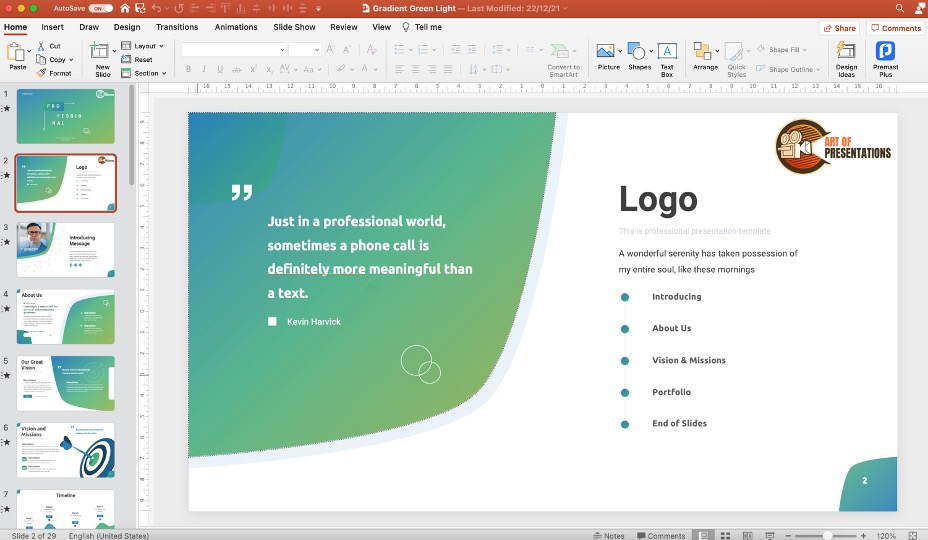
Microsoft PowerPoint is a widely accepted file format where slides are used to convey information. It is a standard component of the Microsoft Office Suite and is compatible with Google Slides, Keynote, and other open-source presentation software.
According to some research results regarding the popularity and use of presentation software, it is estimated that PowerPoint is currently installed on more than a billion computers worldwide ! It is believed that there might be about 30 million PowerPoint presentations created every day.
The advantage of using such a popular and widely used software program is that it is most probably a familiar program for the person you share a presentation with.
2. Wide Variety of File Export Options
A great advantage offered by PowerPoint is that you can export the whole presentation, or parts of it, in a variety of formats. PowerPoint presentations can also be made available on many different devices, and you can always control what content you want to display.
As you don’t have to send a presentation necessarily in .ppt or .pptx format, the receiver doesn’t require PowerPoint or PowerPoint Viewer to open the presentation.
You can export in PDF format and your layout and design will not be altered. The presentation’s slides can also be saved and exported in .png or .jpg format.
If needed, a presentation can also be exported to a video and saved in Mp4 format. If gifs form part of your presentation, they can be saved and exported as Animated GIFs .
You always have the print option to export your presentation or parts of the presentation to Word. When you’ve exported it to Word the content can be edited before printing it.
Whichever way of exporting you decide on, you can export the presentation either as a whole or only some of the slides. And it can be sent as an attachment with an email or you can use the Cloud to facilitate the saving and exporting processes of the presentation.
3. Provides huge Flexibility in Design & Creativity
PowerPoint provides huge flexibility in design and creativity. You can, for instance, use its visual hierarchy features when you create your slides. With this feature, you assure that the right elements and content catch the eye.
Other features include the merging of shapes, the creation of layers, and the creative use of color. You also get an eyedropper tool in PowerPoint that allows you to use any color from your screen in your presentation!
With the Design Ideas feature , you can create the content of a slide and PowerPoint will offer you a variety of design choices to make it better.
The design features PowerPoint offers can in many aspects be compared to advanced design software solutions like Adobe InDesign. You don’t need separate software to design your slides – PowerPoint provides you with built-in features.
4. Allows you to Use Creative Templates
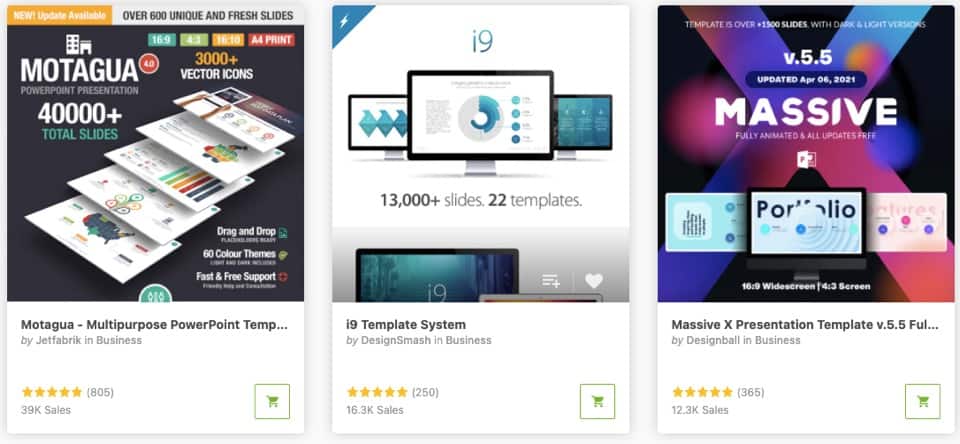
The designs of your presentations are what catch the eye and help you to convey your message to your audience. PowerPoint’s creative templates spare you the time of designing your own templates.
However, if you are a good designer yourself, PowerPoint allows you to create your own templates if you want to.
Note – Check out some of the most popular PowerPoint templates on the internet!
When using PowerPoint’s creative templates feature, it automatically generates design ideas to choose from. You get virtually unlimited options because this feature matches the content you are creating to professionally designed layouts in the background.
This template creation feature is a great advantage for users without any design background. It lets you design presentations that look professional even if you don’t have a design background.
5. Functionality to Use Both Online and Offline
PowerPoint offers you the option to work either online or offline. When you’re using PowerPoint online you can create and share basic presentations directly in your browser.
But it must be remembered that web-based PowerPoint doesn’t have all the features that you’ll have access to with desktop PowerPoint. For “normal” presentations the online web version is good enough and you can present your slide show from anywhere where you have internet access.
To utilize all the features of PowerPoint you have to install the software on your desktop device.
PowerPoint offers you the freedom to work online or offline whichever mode suits you the best for a specific presentation. Many PowerPoint users work with both modes – depending on what they are creating and for what purpose.
6. Allows easy Collaboration and Sharing with other Team Members
PowerPoint is an ideal tool to share and collaborate with team members when you are creating a presentation as a team. You have various options.
You can independently create a presentation and then send it to team members for comments or editing. Or you can work simultaneously on the same presentation with others via web-based PowerPoint or by saving your desktop-created presentation in the Cloud.
7. Option to Add a vast Variety of Multimedia
PowerPoint provides you with tools to make any presentation more interesting by using multi-media. When using PowerPoint you can in the same presentation have
- text with the option to install additional fonts ,
- videos and video snippets,
- background music,
- a narrator’s voice explaining the visual material on the screen,
- graphics to illustrate tendencies,
- tables to compare information, and more.
And you don’t need separate tools to create interesting presentations – everything is built-in into PowerPoint. You can either just add the various types of files to the presentation or you can add the formats as such into the presentation.
8. Suitable for Beginners and Advanced Users alike
The versatility of PowerPoint ensures that on the one hand, presentation creators with advanced design skills are not disappointed with the design tools and possibilities offered by PowerPoint and on the other hand, beginners and people without any designing background can create professional-looking presentations.
This is one of the most important advantages of PowerPoint – anyone can use it successfully.
9. Cost is relatively Inexpensive
PowerPoint is normally part of the Microsoft Office package and is included in the Microsoft Office one-off price or subscription. But if you are not a Microsoft Office user, you can purchase PowerPoint from the Microsoft Store at a reasonable price of about $160.
Note – Check out this limited-time deal to get Office 365 1-year subscription for as little as about $60 on Amazon!
Once you’ve purchased PowerPoint you can use it without extra charges to create presentations and to present them for non-commercial purposes. However, there are licensing and relatively small annual fees involved if you use the PowerPoint presentations commercially.
10. Suitable for Teaching
A PowerPoint presentation in the class is an effective way to reinforce content that has to be retained.
With features like the possibility to record your voice to accompany the PowerPoint slides, it is also easy to convert the presentations that have been used in the class into videos to post online. The students can then review the work done in the class at home. T
his method works effectively for academic lessons and training sessions.
PowerPoint presentations online can also sometimes be the only way to teach and train students. During the Covid pandemic, for instance, classes are sometimes not possible and online sessions are the only way to keep on teaching.
A large percentage of these online sessions have started as PowerPoint presentations.
11. Huge Online Community and Microsoft Support for Troubleshooting Issues
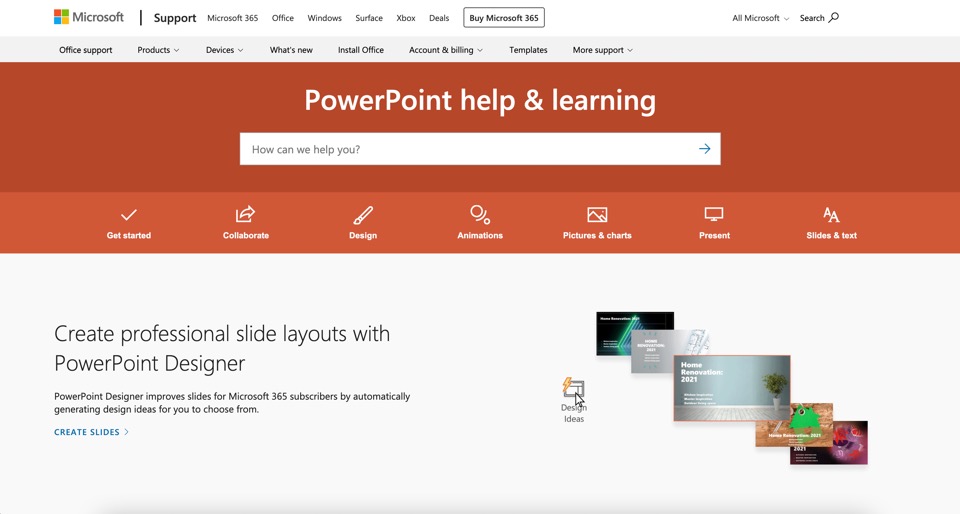
Microsoft offers 24/7 support for PowerPoint users and there are literally hundreds of articles online available on how to troubleshoot issues. The huge online community of PowerPoint users is also actively involved on websites like Quora to help fellow users to get solutions for their issues.
Credit to benzoix (on Freepik) for the featured image of this article (further edited)
Like what you're reading?
Creating engaging teacher presentations: tips, ideas, and tools
Get your team on prezi – watch this on demand video.
Anete Ezera August 21, 2024
Teacher presentations should effectively convey information, engage students, and enrich the learning process. While business presentations often focus on sales or data analysis, educational presentations aim to foster comprehension and spark curiosity. This article delves into the differences between teacher presentations and other presentation types, provides practical tips for educators, and shares design strategies for creating engaging teacher presentations. Additionally, we’ll highlight Prezi , a tool known for its format that offers a refreshing take on educational presentations.

Understanding teacher presentations
Purpose and audience.
The main objective of a teacher presentation is to educate. Whether the presentations are used to introduce new ideas, revisit old topics, or help students understand complex concepts, the main aim is to make the content easy to understand and interesting. In contrast, business presentations usually seek to convince or update stakeholders. A teacher presentation is tailored for the student audience. Ultimately, it should accommodate learning preferences, keep students engaged, and promote participation.
Design and structure
When preparing a teacher presentation, it’s crucial to maintain simplicity. Steer clear of overcrowding slides with information or incorporating flashy visuals that could divert attention from the main message. Opt for a balanced layout that leverages visuals to complement the delivery rather than overshadowing it. Using Prezi , with its non-linear format, empowers teachers to create compelling presentations that flow seamlessly and engage students effectively.
Tips for creating effective teacher presentations
1. know your audience.
Knowing the age, background knowledge, and learning preferences of your students is essential when creating a teacher presentation. Customize your material to suit their requirements, making sure it strikes a balance between being overly complicated and overly simplistic. When presenting to students, make sure to include plenty of visuals and interactive features, and focus on providing in-depth explanations and fostering discussions.
2. Focus on clarity and simplicity
Avoid cluttering your presentation with too much text or too many graphics. Use bullet points to break down information and keep the slides clean. Remember, presentation is a tool to support your teaching, not to replace your voice. The content on your slides should be clear, concise, and directly related to your lesson objectives.
3. Use engaging visuals and media
Using aids like pictures, videos, and diagrams can help improve comprehension and memory of information. Prezi enables you to design captivating presentations with zoom features that assist students in engagingly exploring the material. In contrast to slide decks, Prezi’s canvas offers a natural progression of content, simplifying the task of emphasizing relationships between ideas.
4. Encourage interaction
Incorporate interactive elements into your presentation to keep students engaged. Ask questions, use polls, or include discussion points that require student participation. Prezi’s format supports this by allowing teachers to zoom in on specific points for discussion, making the presentation feel more like a conversation than a lecture.
5. Rehearse and time your presentation
Practicing your presentation ensures that you can deliver it smoothly and confidently. Time your presentation to fit within the class period, leaving room for questions and discussions. A well-timed teacher presentation keeps students engaged and allows for a natural flow of information.
Things to keep in mind when creating a teacher presentation
When preparing a teacher presentation, it’s important to concentrate on developing a useful resource that improves student’s understanding. Here are some dos and don’ts to consider, especially when incorporating images and text, and designing the layout:
Teacher presentation dos:
Use high-quality visuals: Include clear, high-resolution images and graphics that support your lesson content. Visual aids can significantly improve understanding, especially for visual learners. Infographics, charts, and diagrams can be powerful tools to illustrate complex concepts.
Keep text minimal: When creating slides, opt for bullet points and concise phrases. Ensure that your slide content supports your spoken presentation rather than duplicating it. Also, highlight the points that students should keep in mind.
Incorporate multimedia: Use videos, audio clips, and animations where appropriate. These elements can help bring your lesson to life and maintain student interest. However, ensure that any multimedia used directly relates to and enhances the lesson.
Ensure consistent design: Maintain a consistent design throughout your presentation. Use the same font, color scheme, and layout style across all slides. Consistency helps create a professional look and makes the presentation easier to follow.
Use contrasting colors: Choose colors that contrast well, especially between text and background. This ensures that your content is easily readable, even from the back of the classroom. For example, dark text on a light background works well, as does light text on a dark background.

Teacher presentation don’ts:
Avoid overloading slides with information: Avoid overcrowding a slide with information. Too much content on one slide can be daunting for students, and it may distract from the key messages you intend to communicate. Strive for a clear design instead.
Don’t use distracting fonts or colors: Avoid using fonts or colors that clash. Opt for fonts and colors that improve visibility without taking attention from the content. Limit yourself to two or three fonts, and avoid using more than four colors in your presentation.
Don’t overuse animations or transitions: Avoid using too many animations or transitions when switching between slides. Although these elements can make the presentation engaging, excessive movement might become a distraction and take away from the educational material. It’s best to use them with intent.
Avoid irrelevant visuals: Avoid adding any pictures or illustrations that aren’t closely tied to the lesson. Even though visuals can improve a presentation, unrelated ones might perplex students and lessen the significance of your points.
Don’t neglect accessibility: Remember to take into account the learning requirements of students. Make sure your presentation is easy for all students to access by using clear fonts, including text for images, and providing transcripts for any video or audio materials.
By following these guidelines, you can create a teacher presentation that not only looks good but also effectively conveys your lesson material. Keep in mind that the aim is to leverage visuals and design features to enrich learning rather than detract from the information.
Exploring teacher presentation tools: spotlight on Prezi
When it comes to creating captivating teacher presentations, selecting the right tool is key. Although PowerPoint and Google Slides are commonly used, Prezi presents an option that can revolutionize the way educators deliver information.
What makes Prezi stand out?
Prezi’s unique presentation style allows educators to deliver information in a more captivating manner. Rather than following a slide progression, Prezi empowers teachers to explore various aspects of their presentations by zooming in and out, creating a storytelling experience rather than a traditional lecture. This method can engage students effectively and simplify subjects by visually emphasizing the relationships among concepts.
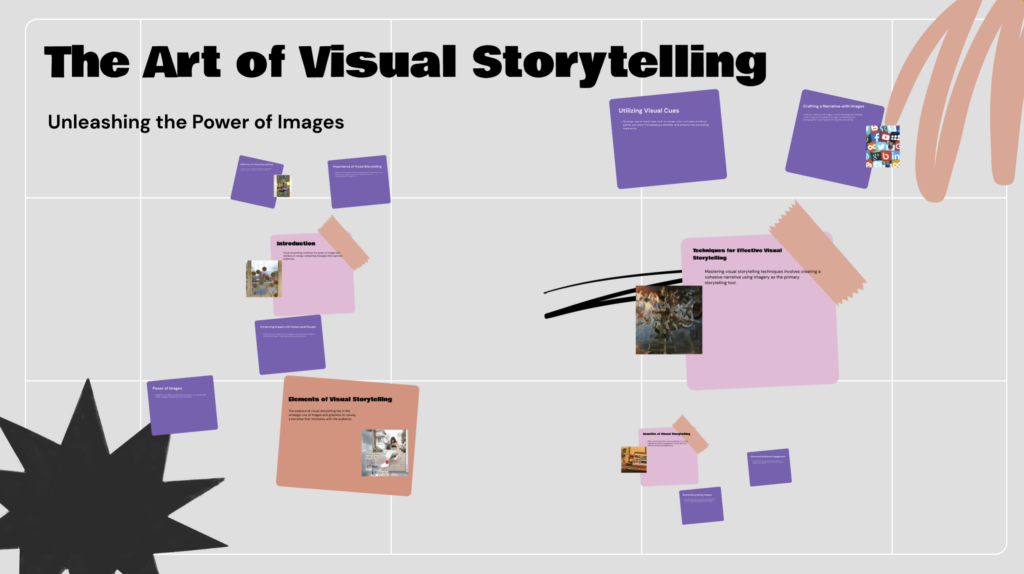
According to research from Prezi, this format is more engaging and memorable compared to traditional slide-based presentations. The study found that Prezi presentations are 25% more effective in keeping audience attention and 20% more effective in making content memorable.
Examples of engaging teacher presentations using Prezi
To illustrate how Prezi can be used effectively in the classroom, here are a few teacher presentation ideas that stand out:
Literacy Genres Prezi Video : This presentation gives a look at types of literary genres using Prezi’s zoom function to delve into each genre extensively. It serves as a method to familiarize students with ideas in an interactive and visually captivating way.
Board Game Lesson Plan Template : This template uses the concept of a board game to structure the lesson, making learning feel like an adventure. It’s perfect for gamifying lessons and keeping students excited about the material.
The Civil Rights Movement VOR : This presentation explores the background of the Civil Rights Movement, showcasing Prezi features to zoom in on events and individuals. It illustrates how Prezi can animate narratives effectively.
Back to School Template VOR : Ideal for the first day of school, this presentation helps teachers introduce themselves and outline class expectations in a fun and engaging way. It’s a great alternative to a traditional teacher introduction PowerPoint.
Light Book Report Template VOR : This is a creative template that inspires students to showcase their book reports, encouraging them to analyze and share their opinions thoughtfully.
For more inspiration, teachers can explore the Prezi Gallery’s Teacher Picks , which offers a variety of templates and examples designed specifically for educational purposes.
Additional teacher presentation ideas
Teacher introduction presentation.
At the start of the year, teachers have a chance to introduce themselves to their students. Using platforms like Prezi, educators can create a narrative that showcases their personality, teaching style, and what learners can expect in the course. Incorporating anecdotes and engaging elements helps in building a rapport with students from the beginning.
Interactive lesson recaps
To enrich learning, think about using Prezi for making summaries of lessons. When wrapping up a unit or lesson, a recap presentation can go over aspects, pose queries, and even incorporate a quiz to improve comprehension. This method strengthens the content and maintains student interest and active participation in their educational journey.
Virtual field trips
The increasing use of tools in education has made virtual field trips more popular as a means to explore the world without leaving the classroom. Teachers can now create tours using platforms such as Prezi, giving students a look at different locations and providing them with an engaging learning experience that improves their knowledge of geography, history, and science subjects.

Try Prezi for your next teacher presentation
In summary, preparing a teacher presentation entails capturing the needs of your audience, emphasizing clarity, promoting interaction, and sharpening your delivery skills. Through platforms such as Prezi, educators can enhance their presentations to captivate students with engaging content. Whether you’re introducing yourself at the beginning of the year, revisiting topics, or guiding students through a virtual excursion, a thoughtfully prepared presentation can enrich the learning experience and leave a lasting impact on your teaching.

Give your team the tools they need to engage
Like what you’re reading join the mailing list..
- Prezi for Teams
- Top Presentations

Pros and Cons of Using PowerPoint in the Classroom
There is a lot of buzz around schools using PowerPoint in the classroom to teach their students. The presentation software of choice is usually PowerPoint. It is the most widely accepted presentation software after all.

Should You Jump on The Bandwagon of Using PowerPoint in the Classroom?
Everything has its Pros and Cons. What are the Pros and Cons of using PowerPoint in the classroom?
You can use this knowledge to decide what to teach using PowerPoint and what to teach without using PowerPoint. Lets get started with some of the biggest Pros and Cons of using PowerPoint in the classroom.
Pro: Great For Introducing New Topics
Using PowerPoint can make the topic look a lot more interesting to the students. That is why it is a very useful tool when introducing a new topic.
Pro: Use of Custom Multimedia is Possible
You can include illustrations, images, even audio and video to the presentation to help the students get a nice introduction and overview of any new topic. It can also be used for specific lessons or the whole course.
Pro: Use of Custom Animation is Possible
Simple custom animations can be used to move things on the screen and reveal more of an image or data as you talk more about it.
Pro: The Slides Can Be Shared With All Students Easily
The school’s LMS can be used to provide students with the slides. The files can also be uploaded to a file hosting website.
This way, the students will be able to access the slides and study from them on pretty much any phone, tablet, or computer device connected to the internet. They won’t need to print or photocopy anything. However, the slides can be printed if needed.
Con: Using A Lot of Text Can Make Using PowerPoint Less Useful
If you like using a lot of text in your classroom Presentations, then its better to just use a textbook or printed notes instead.
Con: Using The Wrong Font and Colors Makes Things Hard To Read
This one is really important. Because, sometimes people make presentations that are really hard to read. Make sure that this does not happen to you. Read the instructions included in this link .
Topics advantages of using powerpoint in the classroom articles on using powerpoint in the classroom disadvantages of using powerpoint in the classroom using microsoft powerpoint in the classroom using powerpoint effectively in the classroom using powerpoint in teaching and learning
Category Presentation Tips
Written by Ahmad
Ahmad is a technology blogger and a Computational Physicist. He breaks down the science of delivering presentations, and shows how to make use of a presentation in business, productivity, and much more
Leave a Reply Cancel reply
Your email address will not be published. Required fields are marked *
Save my name, email, and website in this browser for the next time I comment.
Best PowerPoint Templates
PPT Diagrams & Slide Designs
Microsoft PowerPoint Backgrounds
Privacy Policy
Advertising
- International
- Education Jobs
- Schools directory
- Resources Education Jobs Schools directory News Search

Parent Workshop: Understanding the EYFS PowerPoint Presentation
Subject: Whole school
Age range: Age not applicable
Resource type: Other
Last updated
20 August 2024
- Share through email
- Share through twitter
- Share through linkedin
- Share through facebook
- Share through pinterest

Elevate your parent workshops with our ready-to-use PowerPoint presentation designed specifically for teachers to effectively communicate an understanding of the EYFS framework to parents.
This comprehensive resource simplifies complex concepts with clear, concise content and vibrant visual images that highlight key points, ensuring parents fully understand the key messages.
Save time on preparation and deliver a professional, engaging presentation that fosters strong home-school partnerships. Perfect for busy educators who want to make a lasting impact without the hassle of starting from scratch.
This presentation includes:
- Basic introduction of the EYFS Framework
- Specific learning areas
- The role and important of play
- Tips to help at home
- Assessment and progress monitoring in the EYFS
Tes paid licence How can I reuse this?
Your rating is required to reflect your happiness.
It's good to leave some feedback.
Something went wrong, please try again later.
This resource hasn't been reviewed yet
To ensure quality for our reviews, only customers who have purchased this resource can review it
Report this resource to let us know if it violates our terms and conditions. Our customer service team will review your report and will be in touch.
Not quite what you were looking for? Search by keyword to find the right resource:

IMAGES
COMMENTS
PowerPoint templates are an excellent tool for teaching. They provide a consistent and professional look to your presentations and help keep your ideas organized. Presentation templates also make updating and changing your slides easy, so you can always keep your presentations fresh and up-to-date. When teaching a subject like biology, getting ...
It is easy to use, and it helps students learn in a fun way. The best part about using a PowerPoint presentation is that it allows teachers to present information fun for the students. Powerpoint presentation is an important part of teaching. It helps the students to understand the concepts better. Firstly, it helps to enhance the learning ...
PowerPoints have also helped institutions lower operational costs. While the initial cost of acquiring the system, i.e., laptops, projectors, etc., can be high, schools save in the end through less printing, chalkboard paintings, etc. These are just a few advantages of PowerPoint presentations in education.
This section is organized in three major segments: Part I will help faculty identify and use basic but important design elements, Part II will cover ways to enhance teaching and learning with PowerPoint, and Part III will list ways to engage students with PowerPoint. PART I: Designing the PowerPoint Presentation Accessibility
In the interest of variety, PowerPoint lectures should not be excessively long, but the number of slides used in lectures has no direct impact on teaching effectiveness. However, the amount of text per slide is consequential. One study found that slides containing three or fewer bullet points and twenty or fewer words were more effective than ...
Abstract. The use of PowerPoint for teaching presentations has considerable potential for encouraging more professional presentations. This paper reviews the advantages and disadvantages associated with its use in a teaching and learning context and suggests some guidelines and pedagogical strategies that need to be considered where it is to be used.
PowerPoint presentations are used in many different fields due to their ability to organize and structure information, create a consistent format, and provide the audience with visuals. Educators often use this type of presentation in their classrooms in order to guide the class through a lecture. The effectiveness of PowerPoint presentations ...
Creating an effective PowerPoint presentation. A well-crafted PowerPoint can elevate your presentation, capture attention, and enhance understanding. To help you create it, here's a step-by-step guide. Make a plan. Start by outlining the key points and structure of your presentation.
The experts at the Center examine the advantages and challenges of using presentation software in the classroom, suggest approaches to take, and discuss in detail using PowerPoint for case studies, with clickers, as worksheets, for online (think flipped classes as well) teaching, the of use presenter view, and demonstrate best practices for ...
PowerPoint® presentations in academia have a reputation for being less than engaging in this era of learner-centered teaching. The Net Generation of students also presents a formidable challenge to using PowerPoint®. The problem is that the traditional PowerPoint® in the classroom resembles static electronic overheads that tend
Option 1: Illustrated Lectures. When giving a lecture or mini-lecture, you can use PowerPoint to highlight key points in your presentation. The visual format of PowerPoint allows you to easily project timelines, and images. You can also use PowerPoint to provide an outline of your talk, without writing on the board.
Abstract. Nowadays , PowerPoint is an educational tool for teaching and delivering materials in classes. It was basically developed for. presentation and not essentially for teaching and learnin g ...
For a brief period in the history of teaching, using PowerPoint automatically qualified you as a tech-savvy professor - an innovator who wouldn't settle for the usual combination of staticky ...
Advice from Edelman and Harring on leveraging the working memory with PowerPoint: Leverage the working memory by dividing the information between the visual and auditory modality. Doing this reduces the likelihood of one system becoming overloaded. For instance, spoken words with pictures are better than pictures with text, as integrating an ...
Let's dive in deeper to learn how it can impact your presentations! Table of Contents. 1) Advantages of PowerPoint. 2) Visual appeal and aesthetic design. a) Easy to use and accessible. b) Efficient information organisation. c) Disadvantages of PowerPoint. 3) Conclusion.
In this article, I'll share 7 important benefits of using Microsoft PowerPoint for eLearning applications. 1. Simple yet sophisticated. One of the things I love about PowerPoint is its remarkable balance of simplicity and power. It's a tool that's intuitive enough for beginners to pick up quickly, yet powerful enough to satisfy the ...
Text in a PowerPoint is easier to read than notes on a blackboard. Teachers can easily modify lessons for different classes. Teachers can use PowerPoint to update flashcards. PowerPoint is also useful in creating presentations for parents on their student's progress. It's easy to share a PowerPoint presentation with other teachers and students.
The biggest advantage of using PowerPoint is that PPT files are the most commonly used and widely accepted file formats. PowerPoint is easy to use, cost-effective and boasts a huge online community for support. ... Suitable for Teaching. A PowerPoint presentation in the class is an effective way to reinforce content that has to be retained.
Abstract. Nowadays, PowerPoint is an educational tool for teaching and delivering materials in classes. It was basically developed for presentation and not essentially for teaching and learning in a classroom. Its applications in teaching and learning settings should provide better means of communicating information to the students.
Concerns about PowerPoint and Teaching There are many disadvantages and perils when using PowerPoint in teaching. Namely, they are not related solely to the quality of the software but in its use. Overtime, the presentations became not interactive because only the presenter talks and audience rarely asks or answers the questions.
discusses the advantages of using PowerPoint, its drawbacks and 'how tos' of creating good presentations. as p made it easier for the teachers to keep the students Index Terms interested in class.- PowerPoint, education, presentation, outline, visual aid, reachability, effective slides. good as long as it is relevant to the subject, is of good
Remember, presentation is a tool to support your teaching, not to replace your voice. The content on your slides should be clear, concise, and directly related to your lesson objectives. 3. Use engaging visuals and media. Using aids like pictures, videos, and diagrams can help improve comprehension and memory of information.
Pro: The Slides Can Be Shared With All Students Easily. The school's LMS can be used to provide students with the slides. The files can also be uploaded to a file hosting website. This way, the students will be able to access the slides and study from them on pretty much any phone, tablet, or computer device connected to the internet.
Elevate your parent workshops with our ready-to-use PowerPoint presentation designed specifically for teachers to effectively communicate an understanding of the EYFS framework to parents. This comprehensive resource simplifies complex concepts with clear, concise content and vibrant visual images that highlight key points, ensuring parents ...